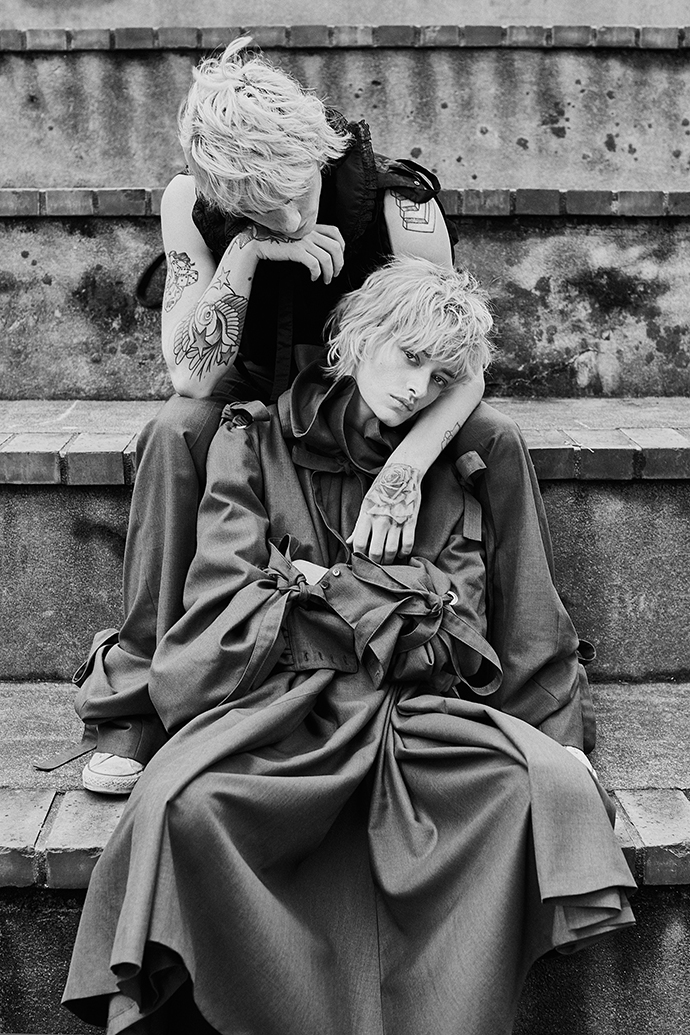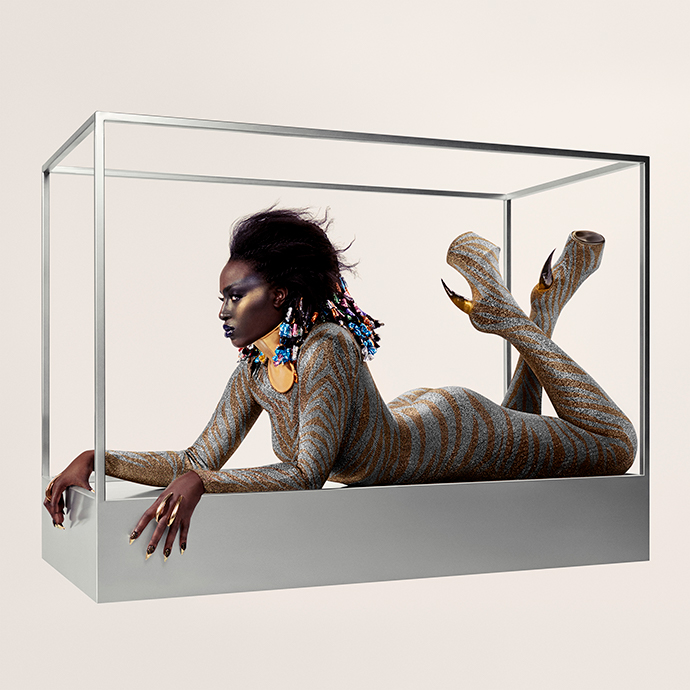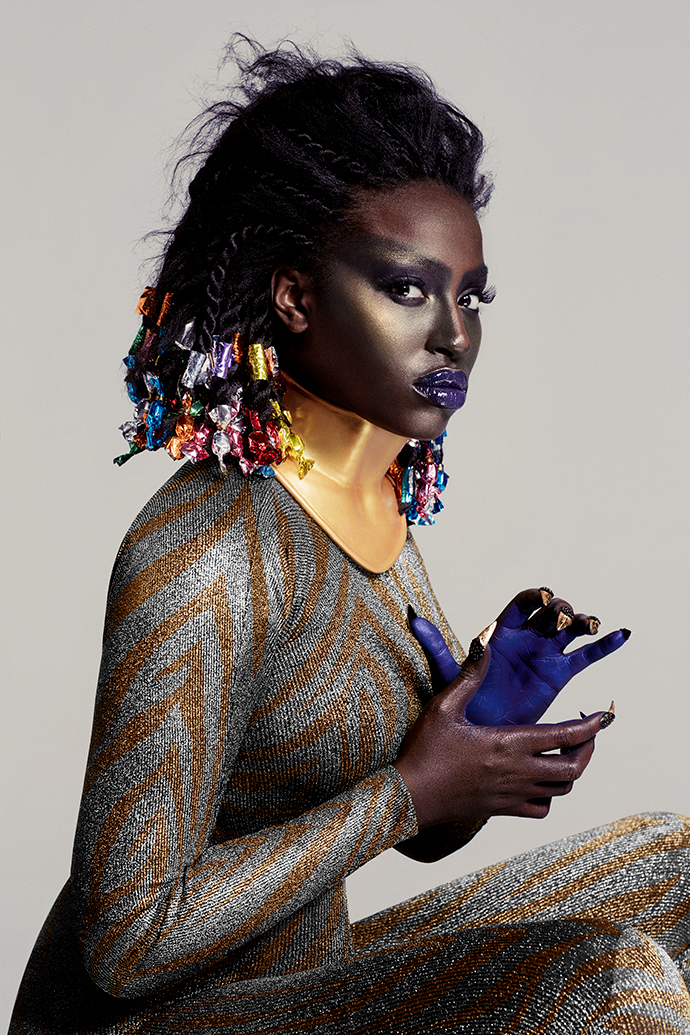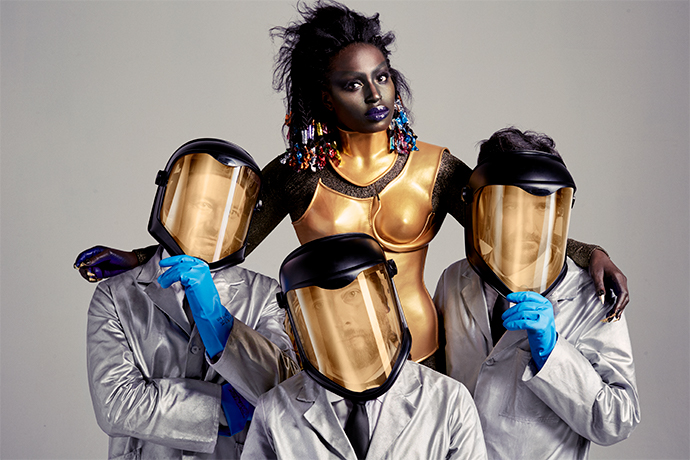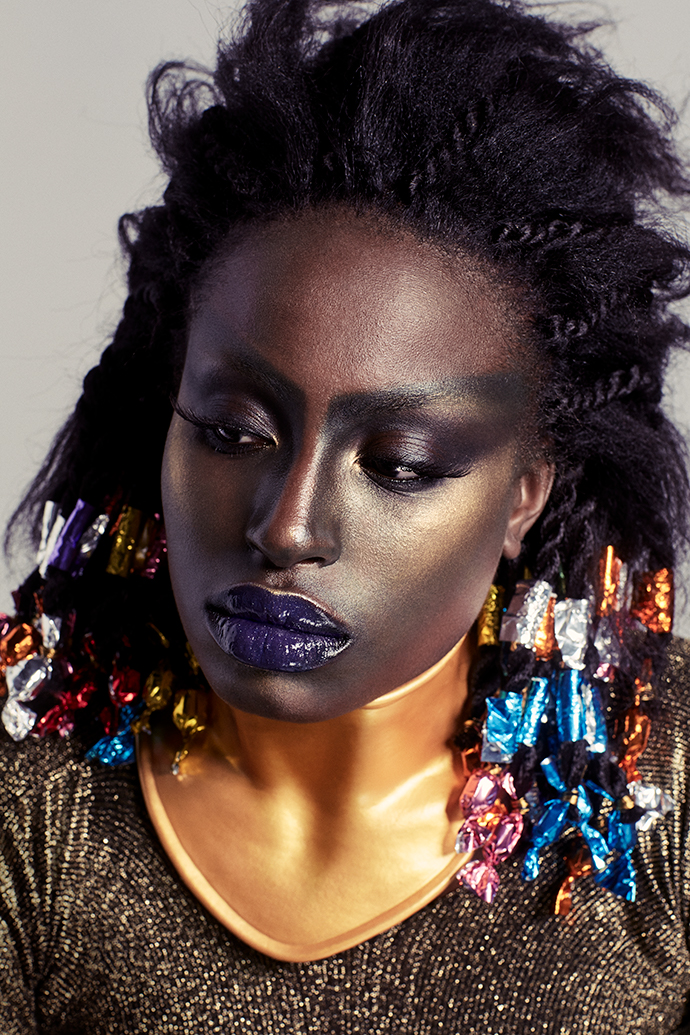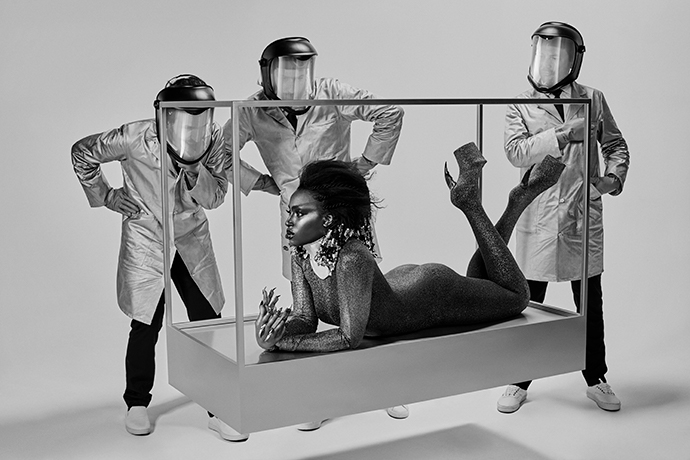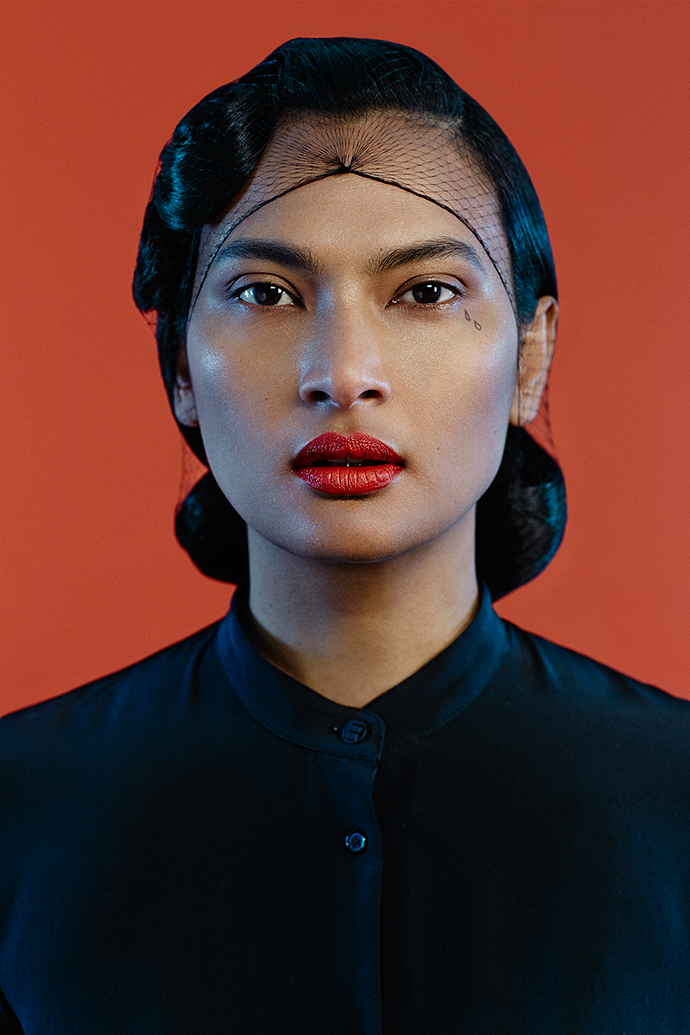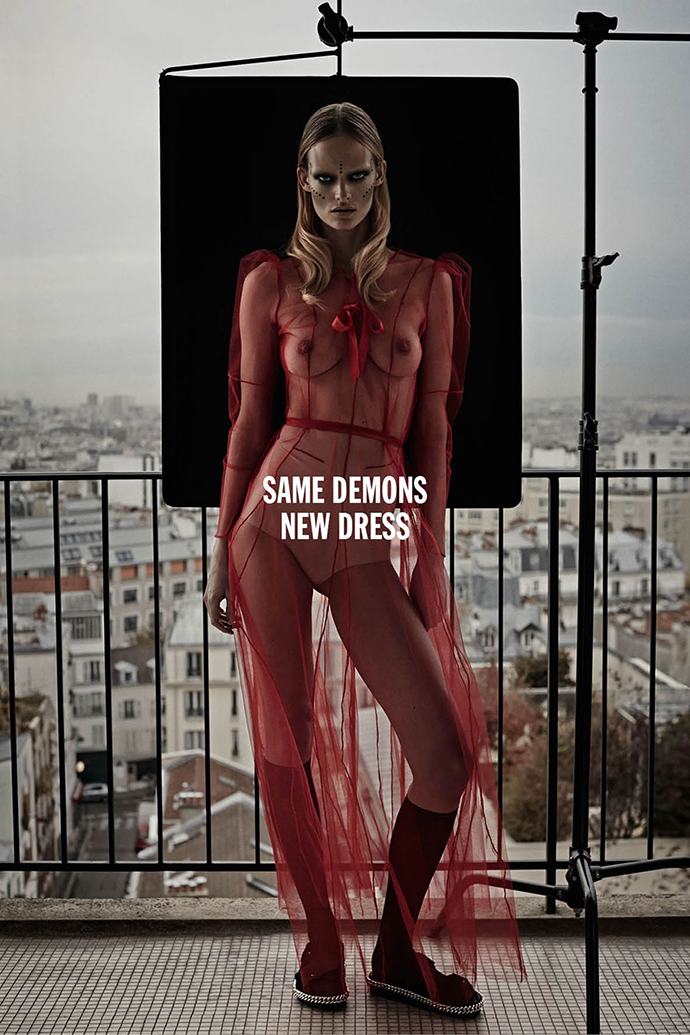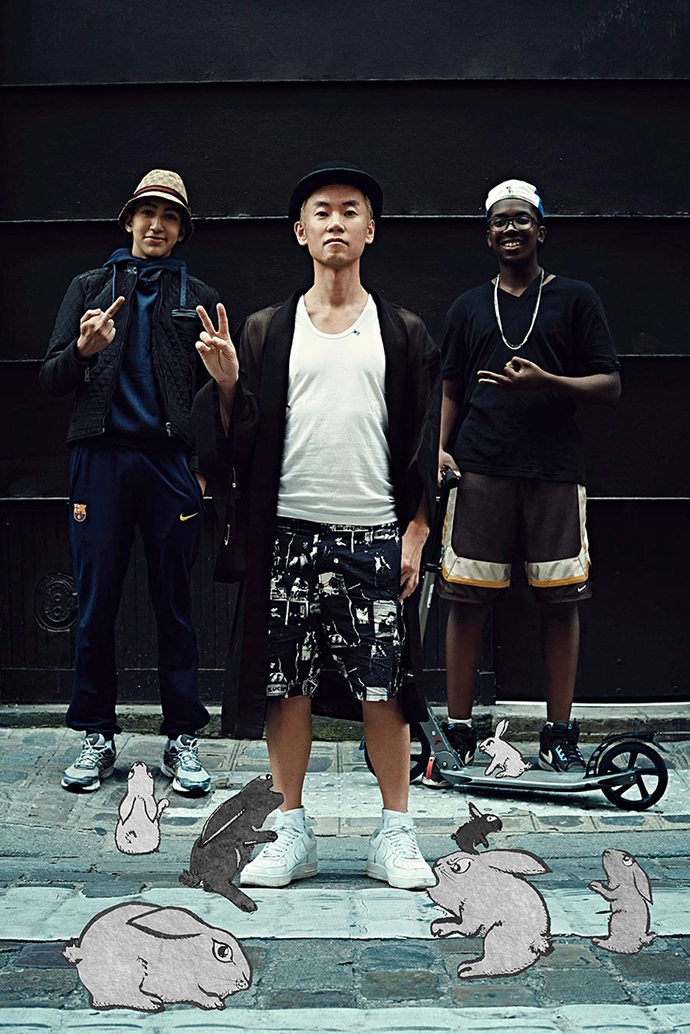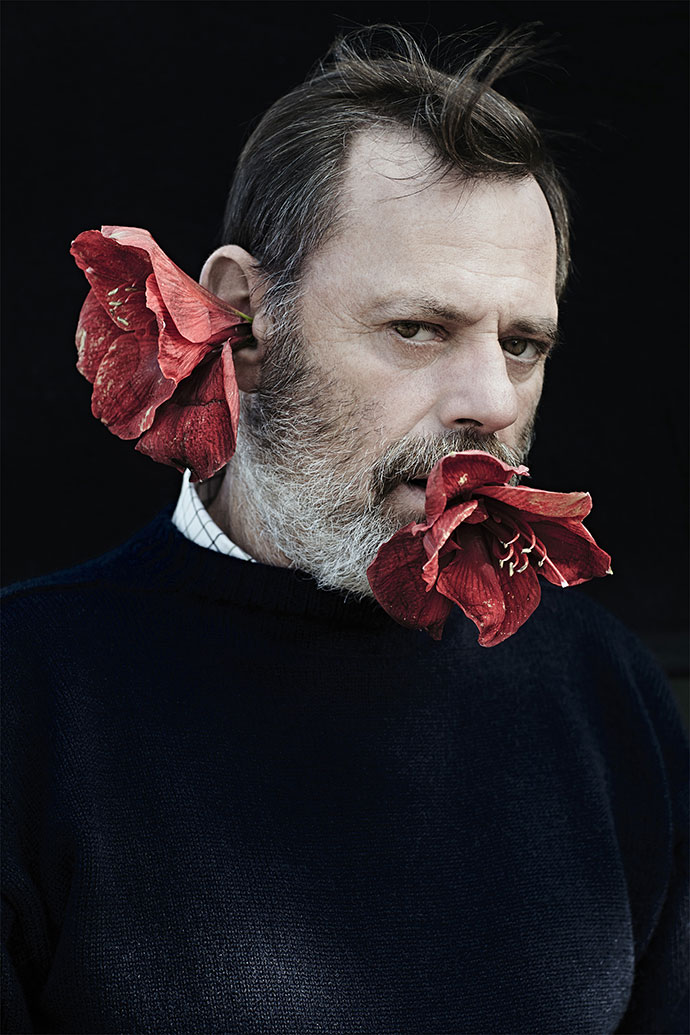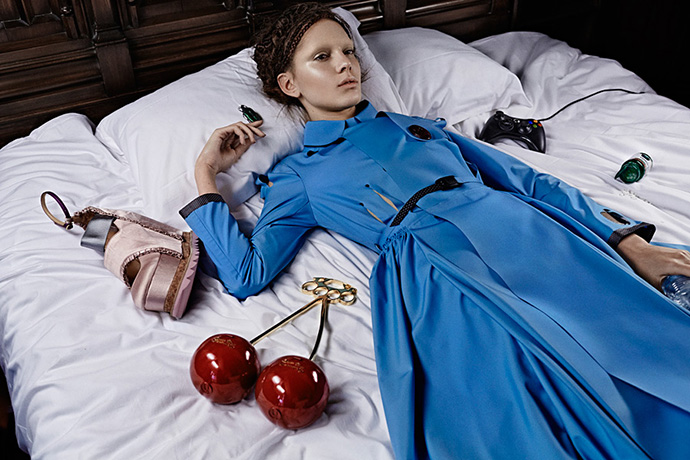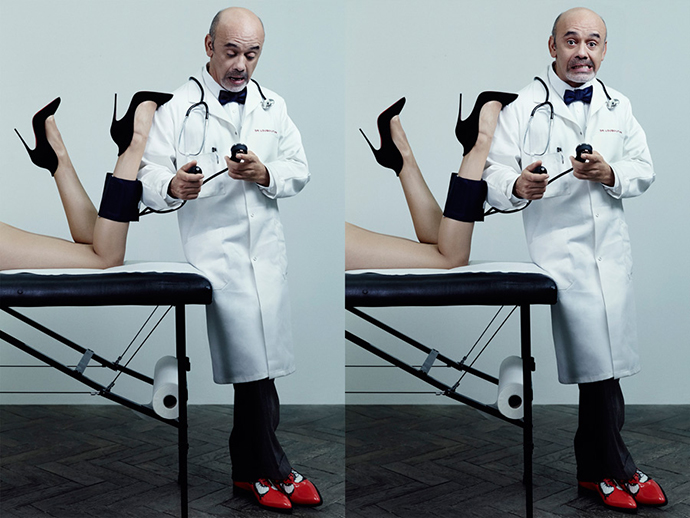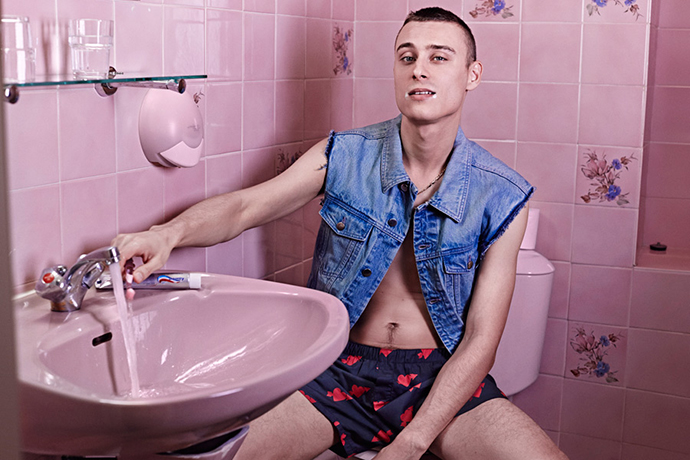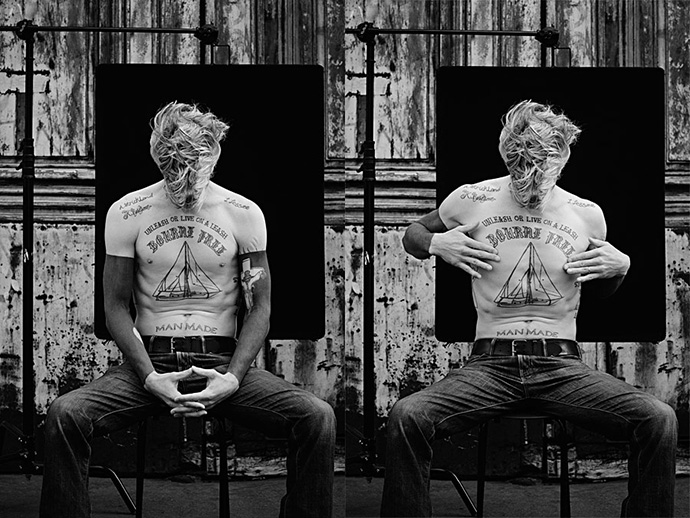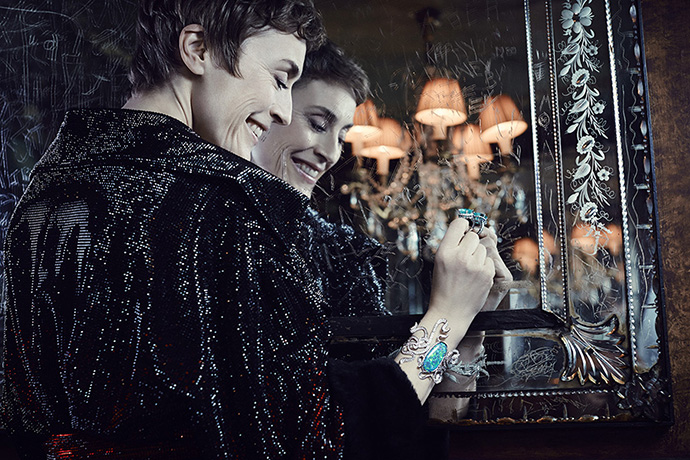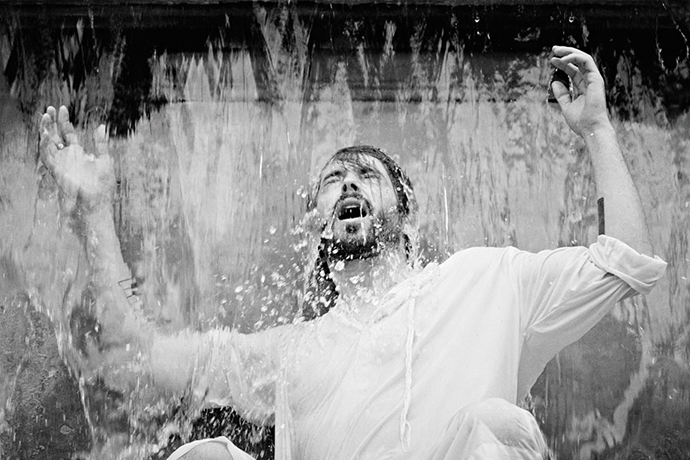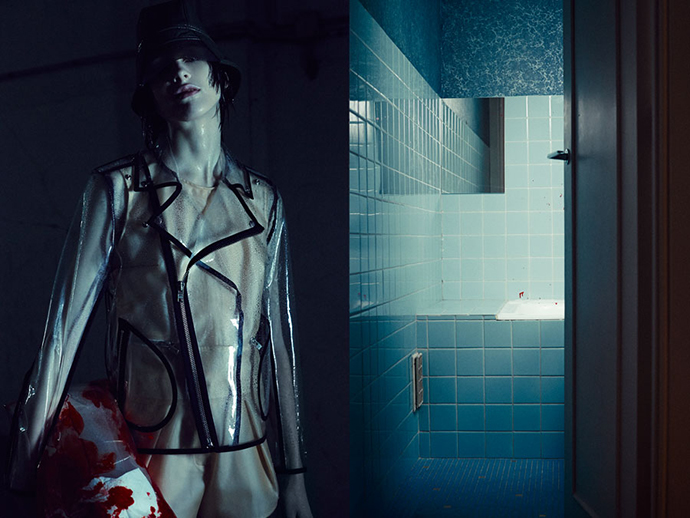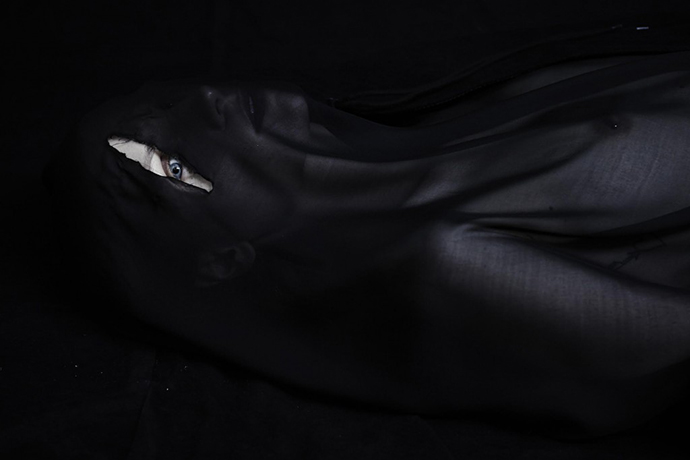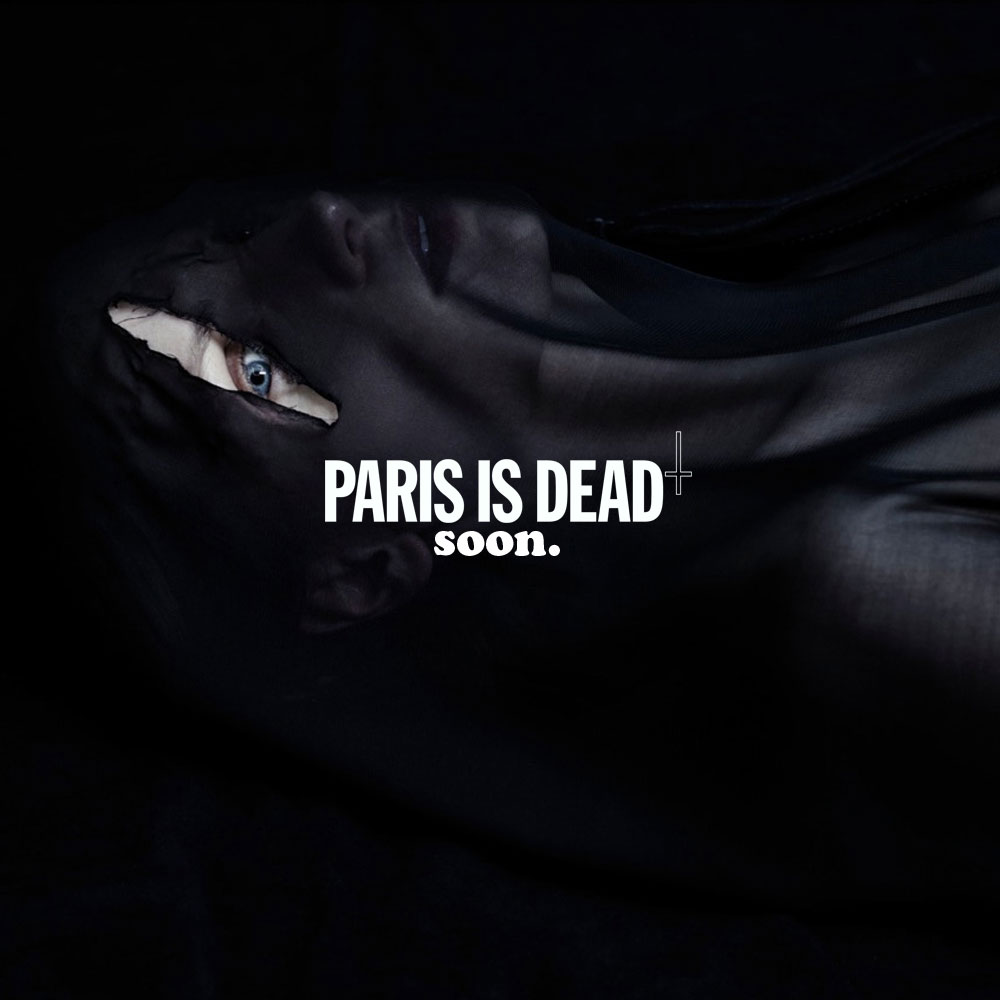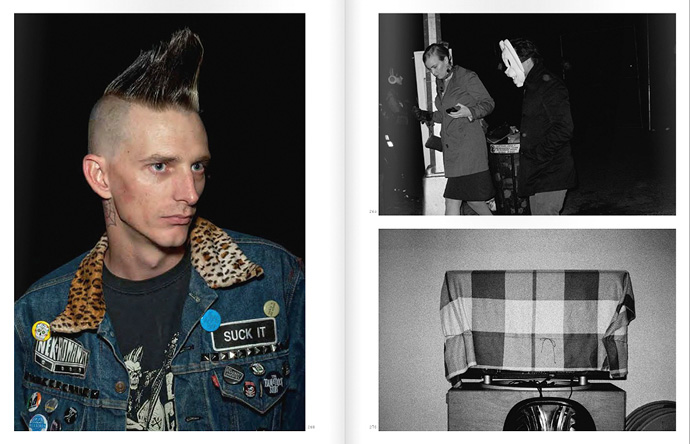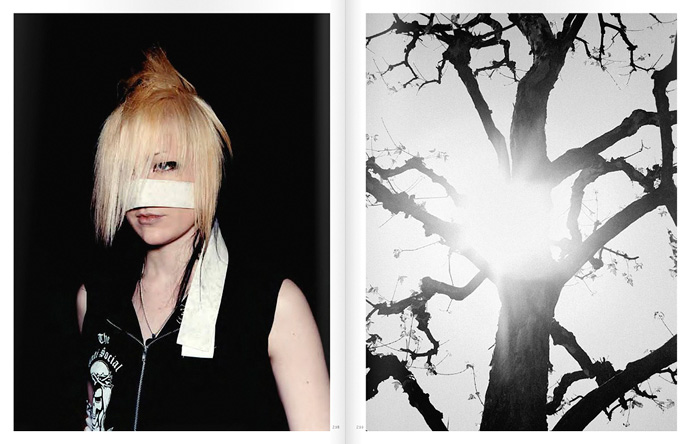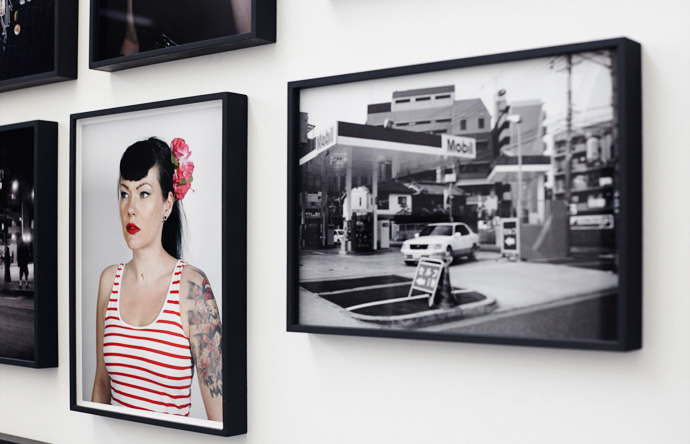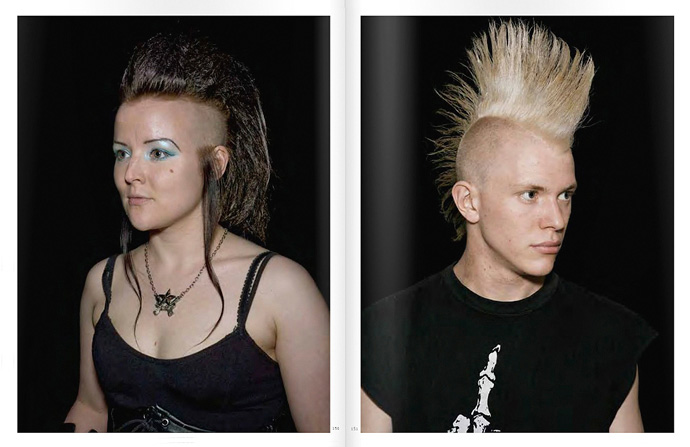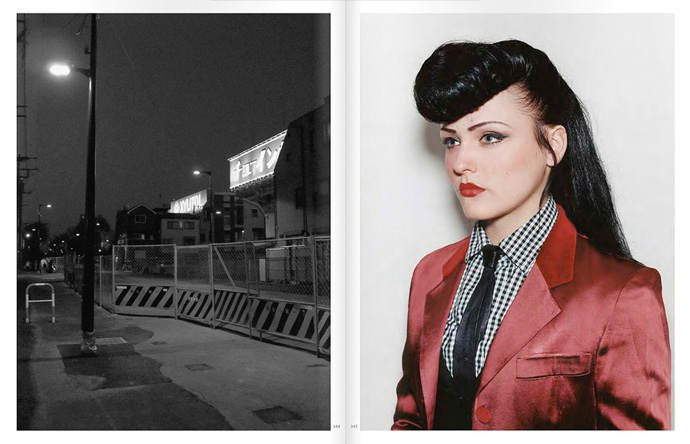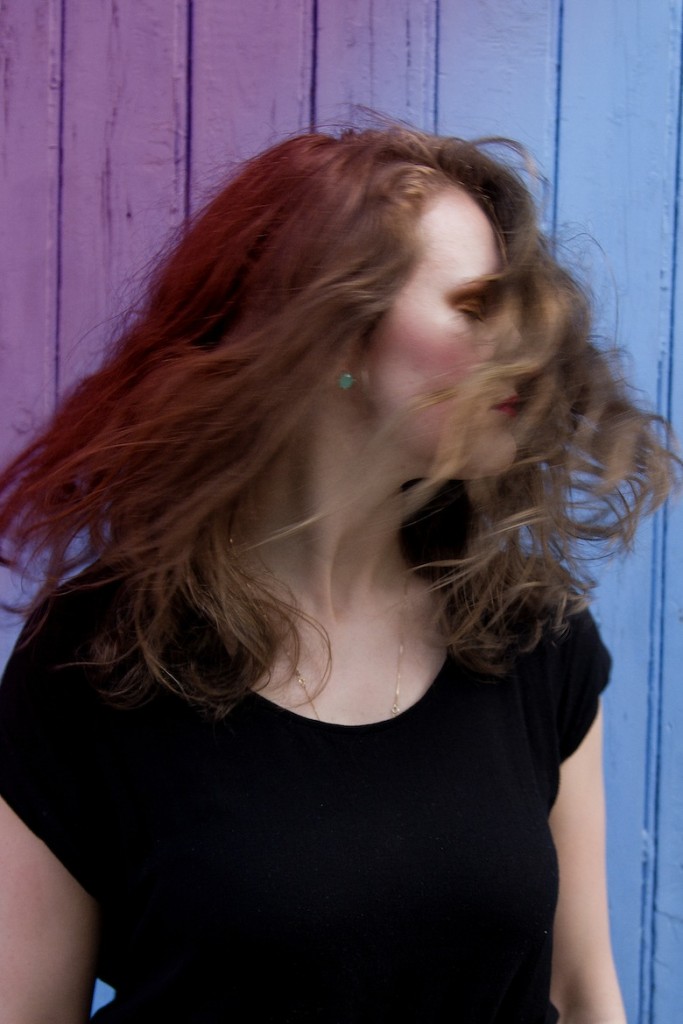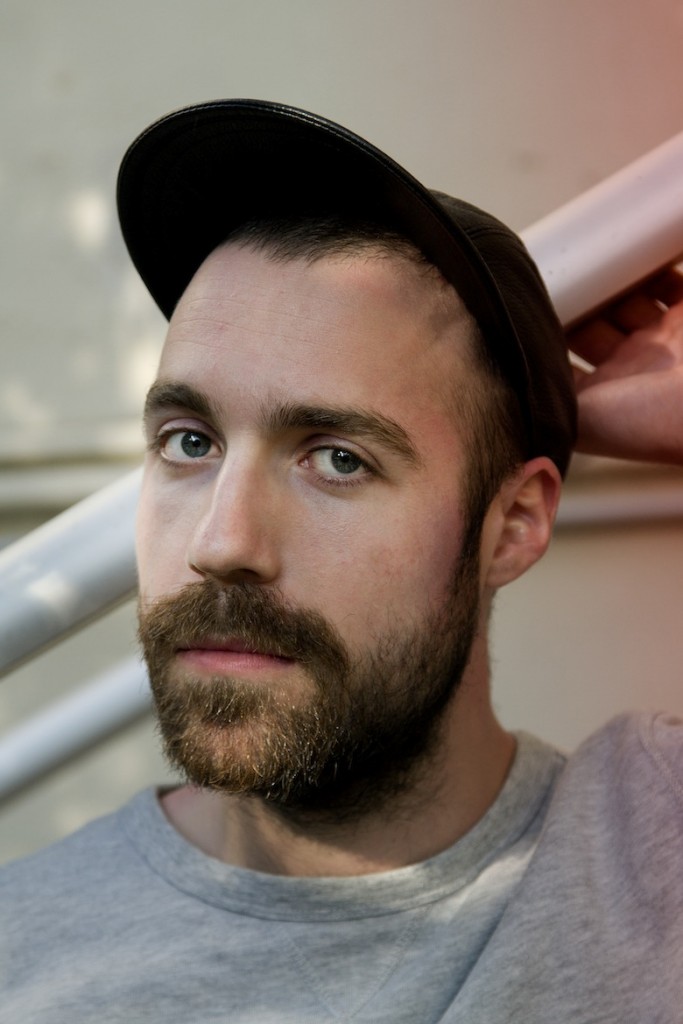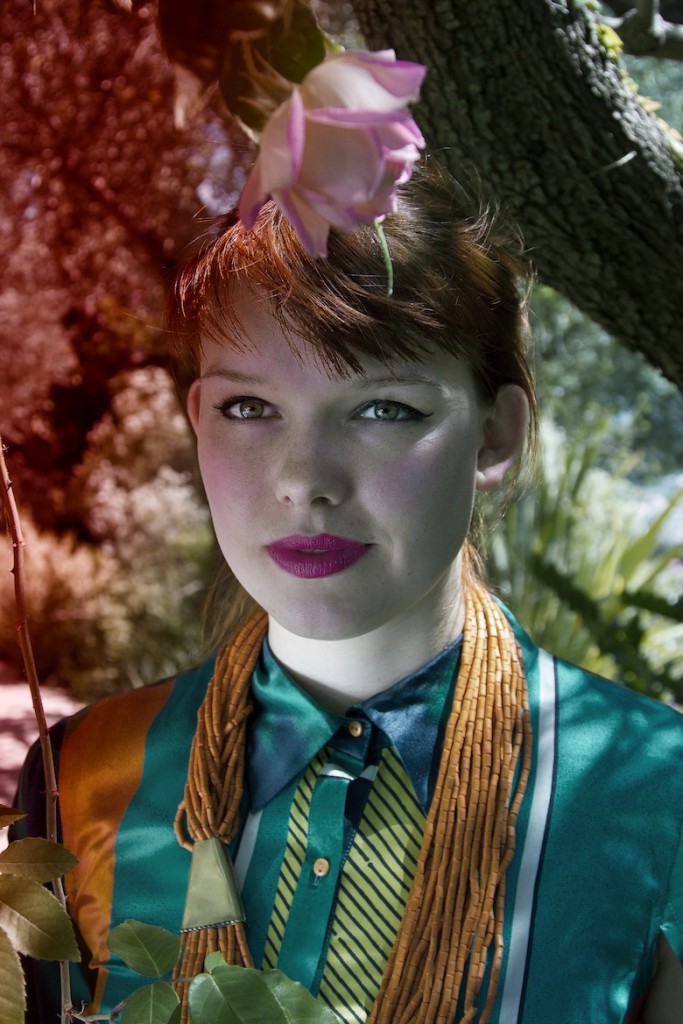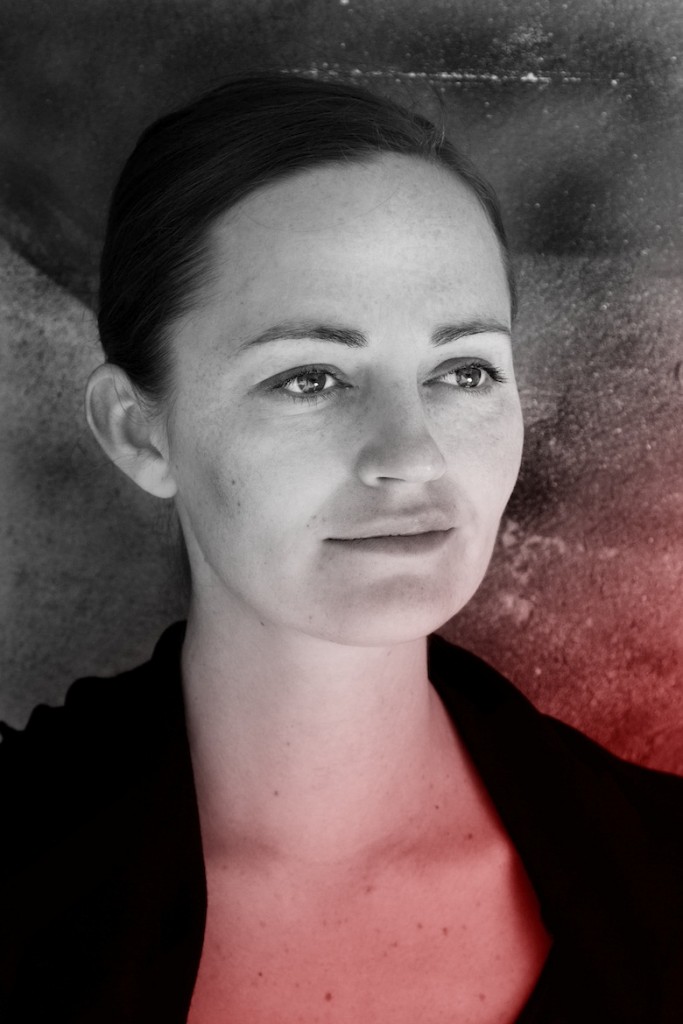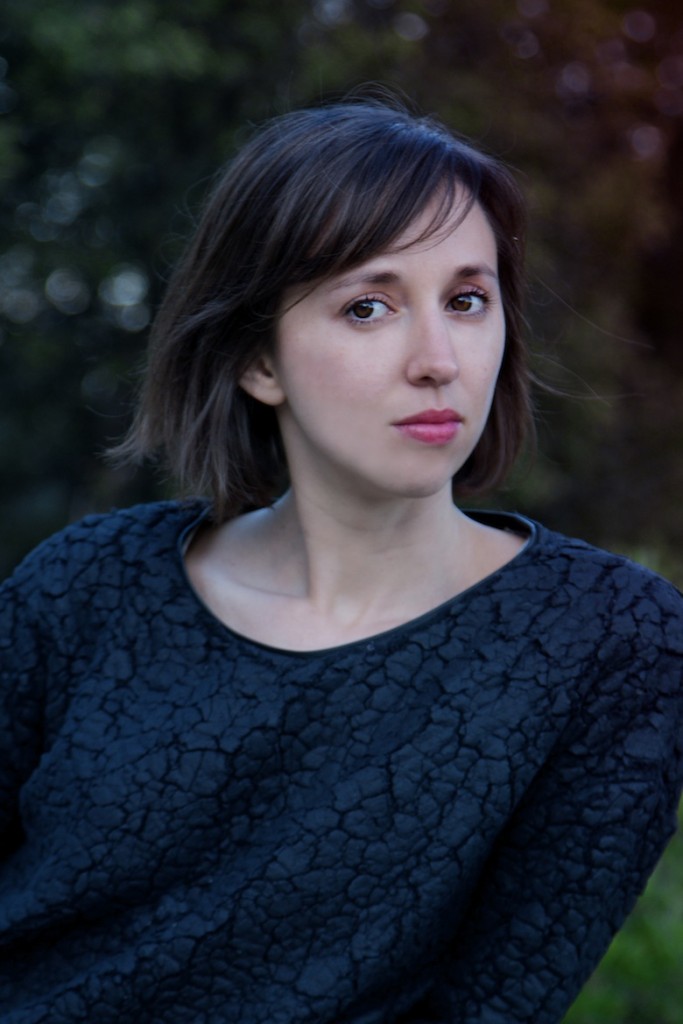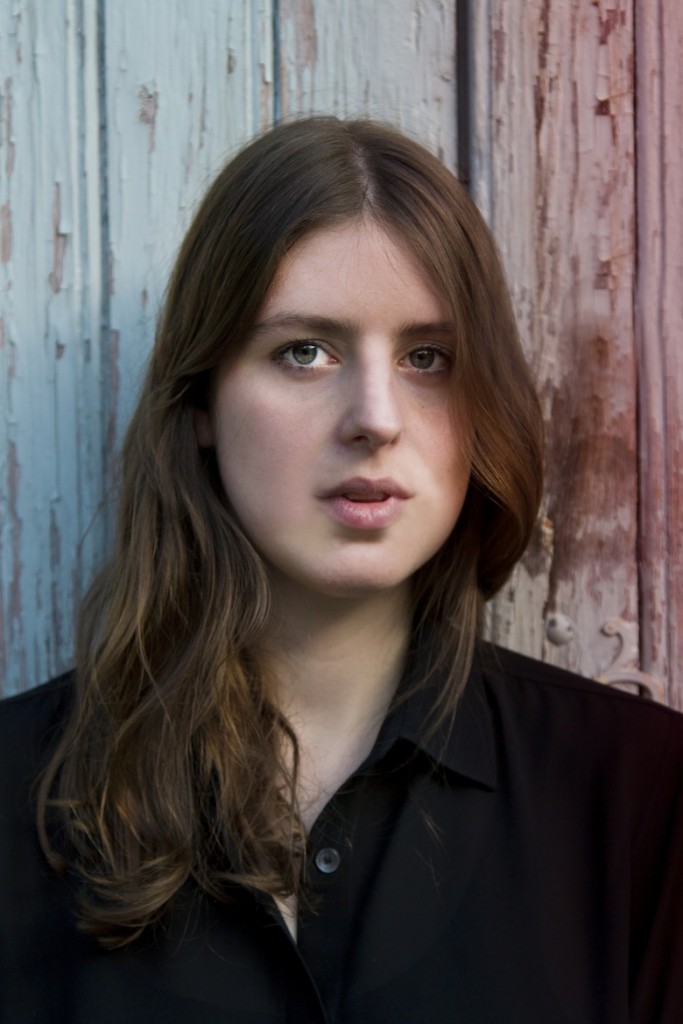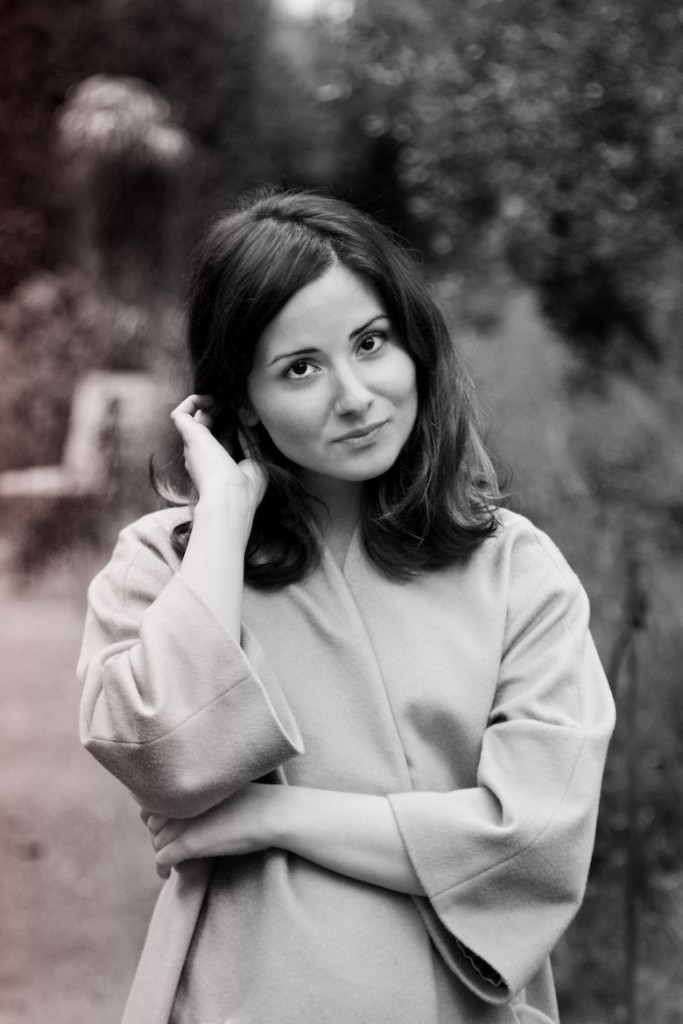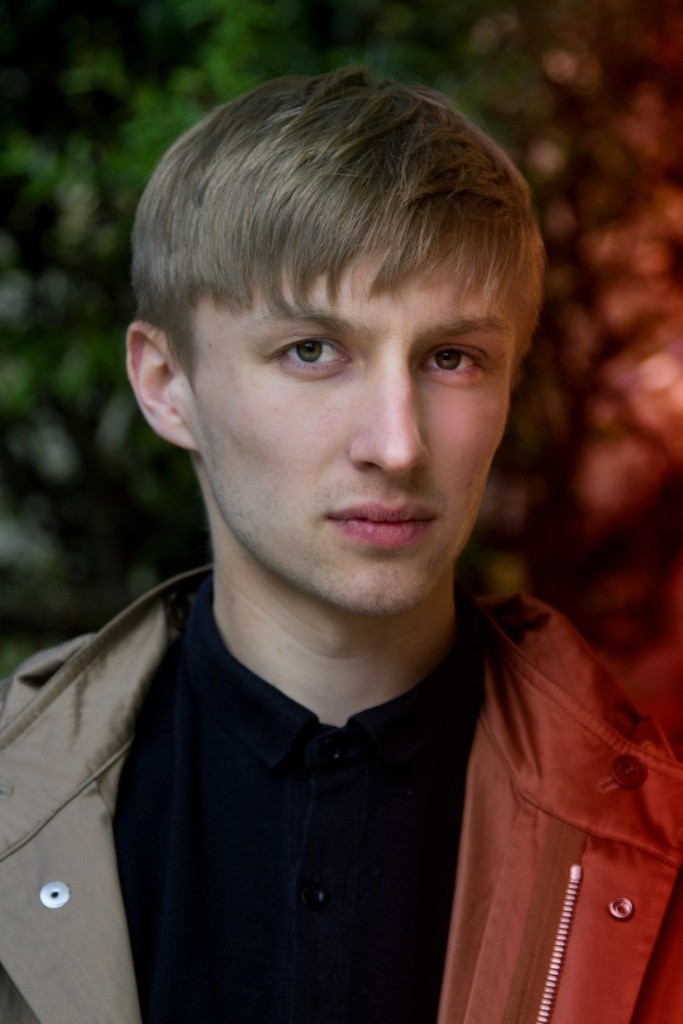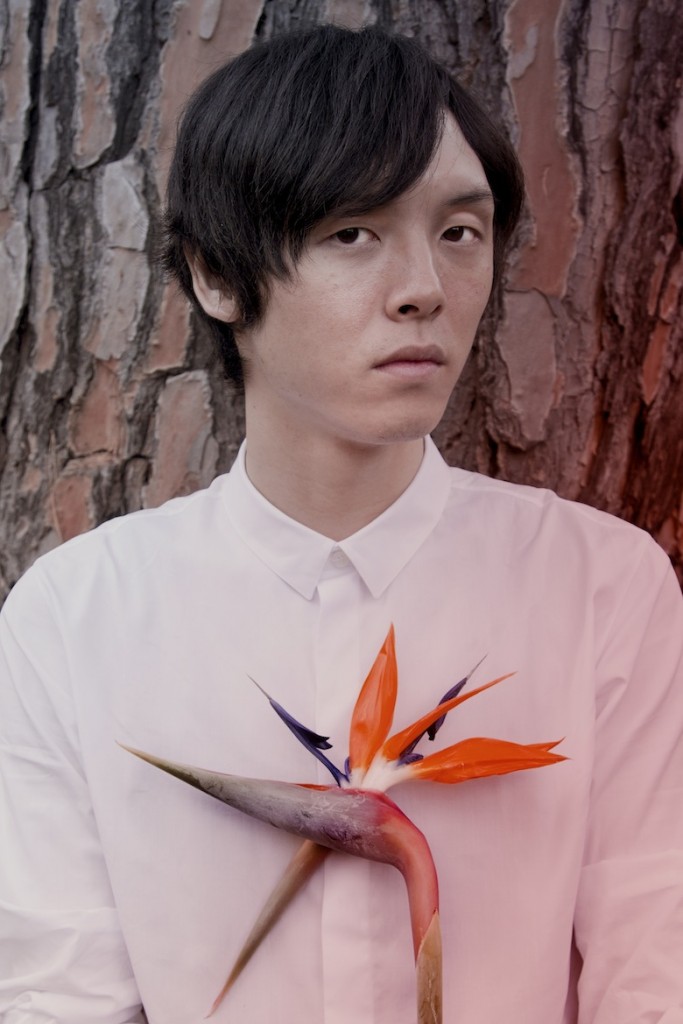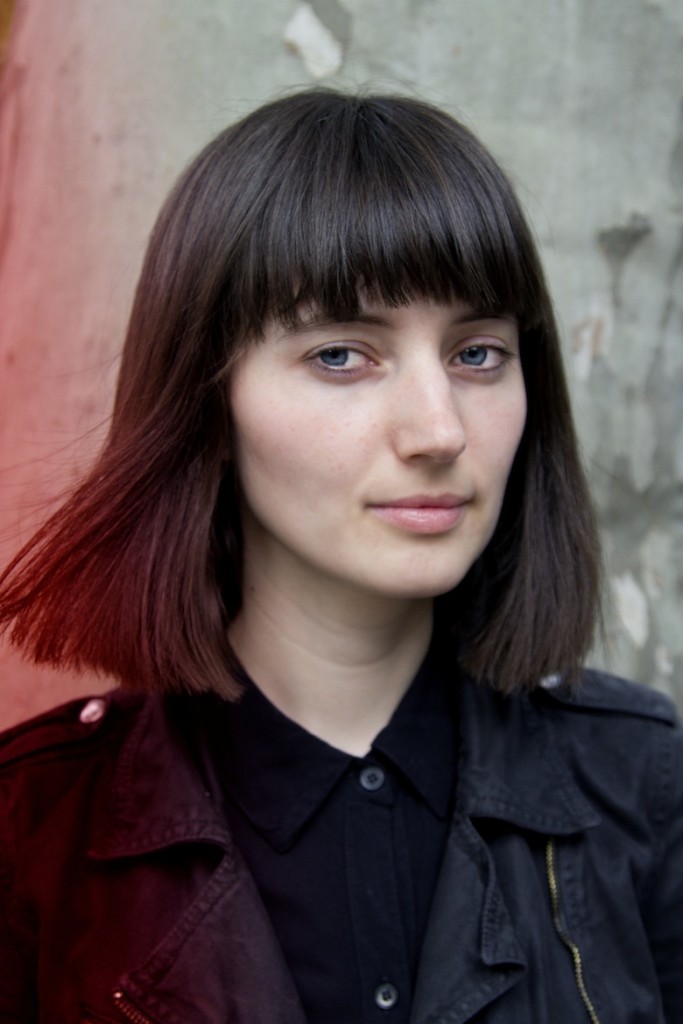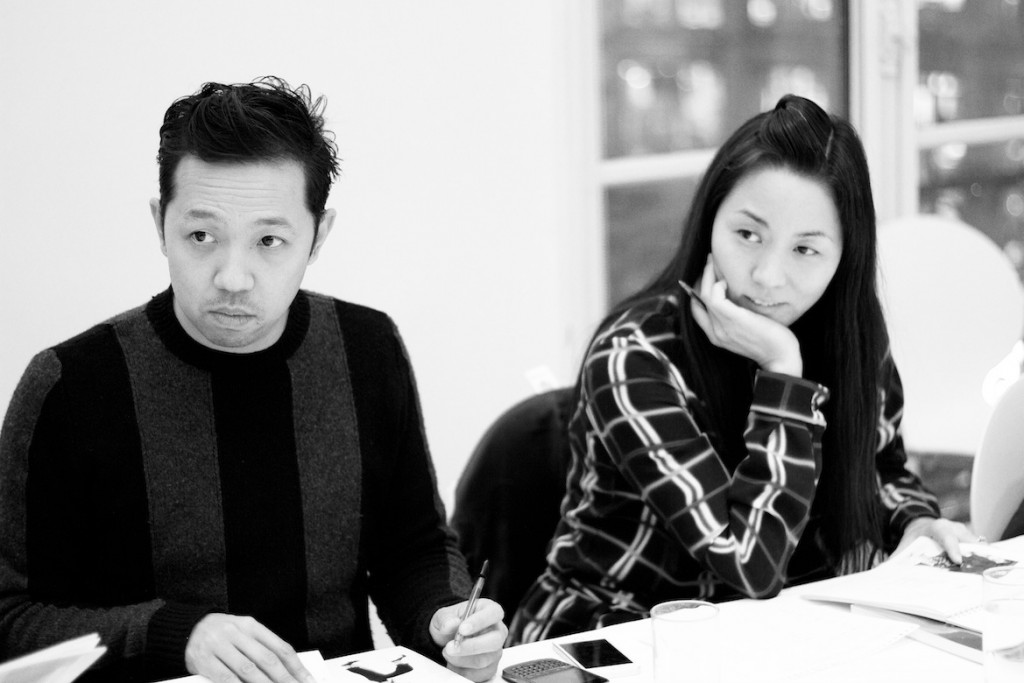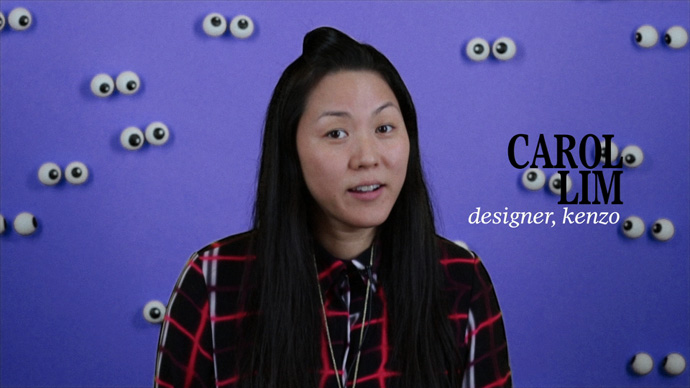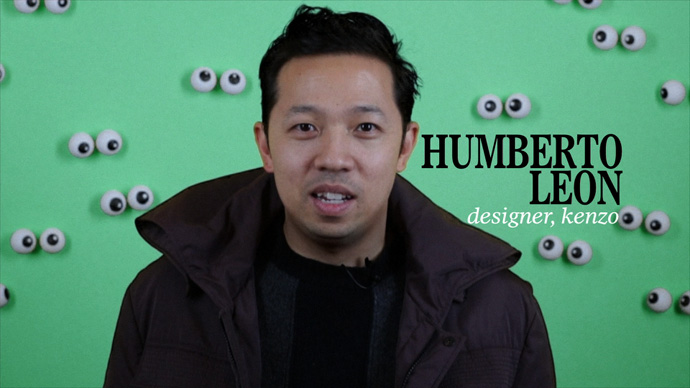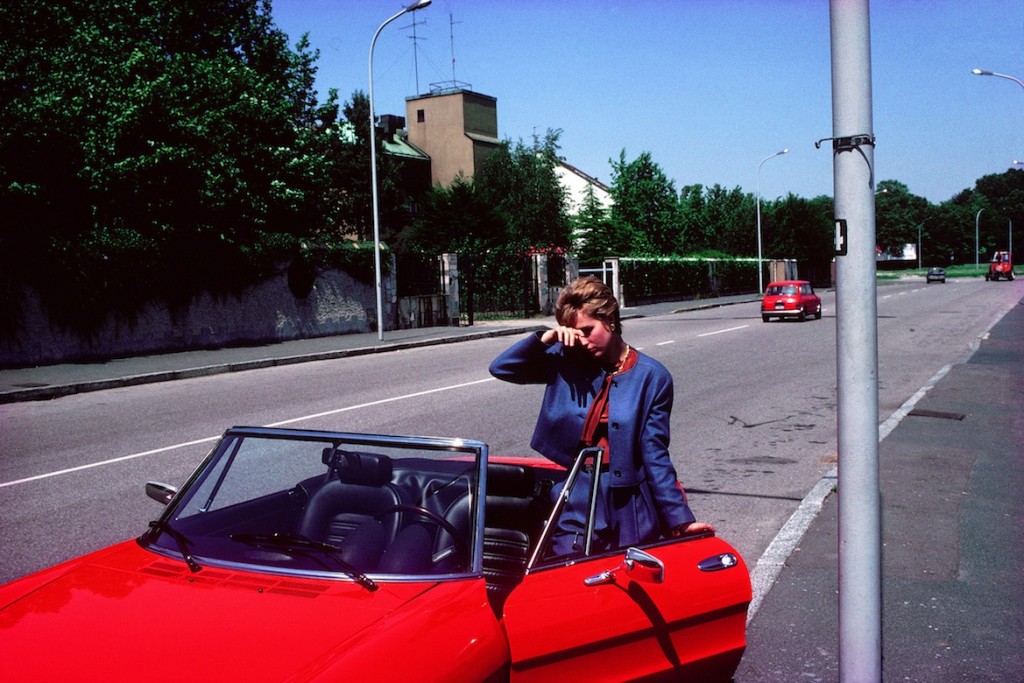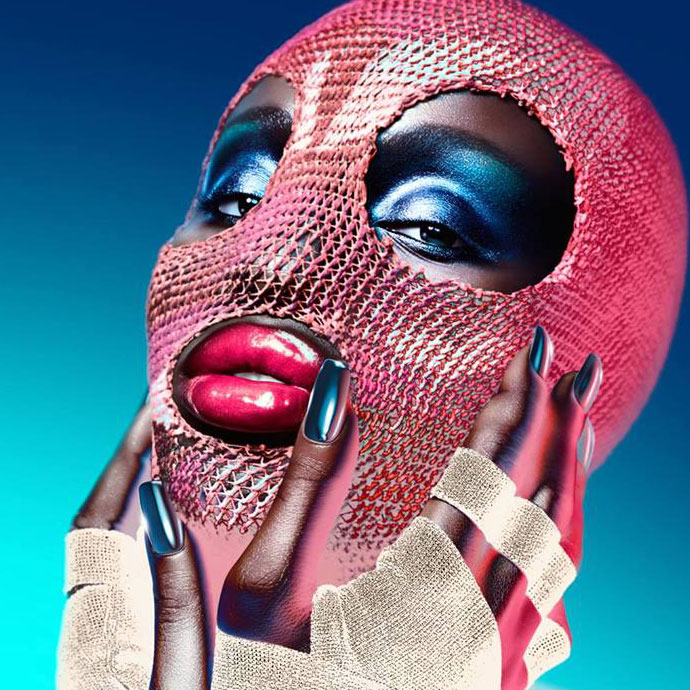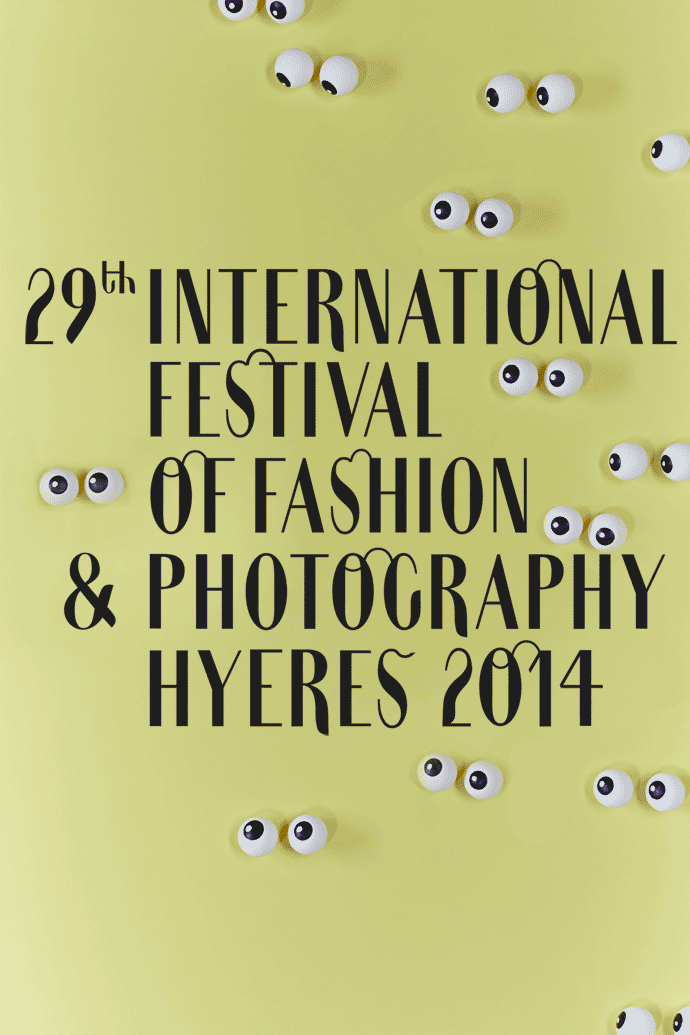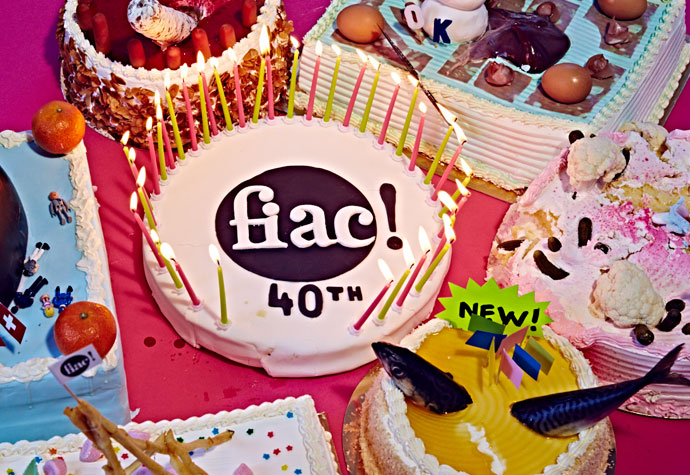-
paris is dead – creation generations
-In the late 1980’s Irene Silvagni fought for new generation of talent until she had to face a tough choice – sell-out or pack-up.
(Hint: she didn’t sell-out).
Fast-forward to today.
Can Paris still give talent a chance, can there a new creation generation ?
Photography by René Habermacher.
Creative direction by Antoine Asseraf.
Styling by Rogelio Burgos.Hair by Panos Papandrianos @ CLM.
Make-up by Yannis Siskos @ Airport.
Production assistant Marion Louapre.Models: Nadine Strittmatter @ Next, Zoe Alayrangues, Paul L @ Rockmen, Timothée @ M Models, Florentin @ M Models.
Clothes by Drome, Icosae, Koché, Léa Peckre, Neith Nyer and Y/Project.
Special thanks to Versae @ Next, Adrianna @ Rockmen and Guillaume @ M Models.
read the full story on PARISISDEAD.COM
01 -

Rocky – Soft Machines
-Label G.U.M. and The Stimuleye present
Rocky’s first album “Soft Machines”,
out October 21, 2016.Photography by René Habermacher.
Art Direction by Antoine Asseraf.ROCKY SOFT MACHINES Cover Atwork by René Habermacher.
ROCKY SOFT MACHINES Artwork by René Habermacher.
ROCKY SOFT MACHINES Artwork by René Habermacher.
ROCKY SOFT MACHINES Artwork by René Habermacher.
ROCKY SOFT MACHINES Artwork by René Habermacher.
styling: Rogelio Burgos
make-up: Min Kim @ Airport
nails: Hiro @ Jed Root
hair: Chiao Chenet @ Airport
retouching: Dimitri Rigas
production: The StimuleyePre-order CD & VINYL of “Soft Machines” from Fnac here.
Watch Rocky’s “Chase the cool” music video by The Stimuleye from their first EP here. -
paris is dead – eat fuck pray
-Food. Friends. Lovers. Family. Music. Beauty.
It’s time to focus on the essentials.Conducted by René Habermacher.
Transcribed and edited by Edward Siddons.Photography by René Habermacher.
Creative direction by Antoine Asseraf.
Styling by Suzanne von Aichinger.Hair by Marc Orsatelli.
Make-up by Ismael Blanco.
Production assistant Marion Louapre.
Retouching by Dimitris Rigas.All looks by Kenzo.
Special thanks to Jirawat Maan Sriluansoi and the Kenzo team.
read more on PARISISDEAD.COM
-
paris is dead – THE 7 RABBIT LIVES OF MR. KAWAHARA
-IT STARTED THE MOMENT HE LANDED.
ON THE CHARLES DE GAULLE RUNWAY, WHITE RABBITS.
FROM THAT PRECISE MOMENT ON, SHINSUKE KAWAHARA’S OBSESSION WAS SET IN MOTION.
Conducted by Antoine Asseraf, René Habermacher, and Suzanne von Aichinger.
Transcribed and edited by Edward Siddons.
Photography by René Habermacher.
Illustration by Shinsuke Kawahara.
Creative direction by Antoine Asseraf.read more on PARISISDEAD.COM
-
paris is dead – in bloom
-Louis Benech is the landscape genius behind the Tuileries gardens, high place of both culture and cruising.
Benech now takes on Versailles, bringing contemporary art to the sun-king’s domain with his new design for the Bosquet du Théâtre d’Eau [Water Theater grove], featuring an installation by artist Jean-Michel Othoniel.
Photography by René Habermacher.
Styling by Suzanne Von Aichinger.
Creative direction by Antoine Asseraf.Transcription by Marion Louapre.
Retouching by Dimitris Rigas.Shot at Bosquet du Théâtre d’Eau, Chateau de Versailles, opening May 12th 2015.
read more on PARISISDEAD.COM
-
paris is dead – deep purple
-The fashion fantasies of Jun Takahashi, mastermind of the Undercover label, always seem to tell us a story.
Like a phoenix in reverse, Undercover’s haunting impression inspired writer Ingrid Astier to write a short exclusively for Paris is Dead – ‘Deep Purple.’
Photography by René Habermacher.
Styling by Suzanne Von Aichinger, all looks by Undercover.
Creative direction by Antoine Asseraf.
Production by Agathe Rousselle, assisted by Marion Louapre.
Colour management by Dimitris Rigas.Portrait of Ingrid Astier: Hair by Philippe Mensah @ L’Atelier(68) / Make-up by Min Kim @ Airportagency.
Undercover: Starring Tako @ Next / Hair by Marc Orsatelli @ Agence Aurelien / Make-up by Min Kim @ Airportagency.
Special thanks to Versae Vanni, Jun Takahashi, Chieri Hazu, Hiromi Otsuka, Giorgio Martinoli, Hôtel Saint Merri, La Perouse, Alice Revet.read more on PARISISDEAD.COM
-
paris is dead – killer heels
-“Heels are dead,” they’ve been saying.
His heels are not dead, they’re just beyond life.
These are killer heels we’re talking about.
Photography by René Habermacher.
Styling by Suzanne Von Aichinger, with Louboutin shoes.
Creative direction by Antoine Asseraf.Interview by Antoine Asseraf & Suzanne von Aichinger.
Transcribed by Marion Louapre.
Translated by Ed Siddons.Starring Agathe Rousselle and Charles Boutheloup.
Grooming by Debora Emy @ Airport Agency.
Special thanks to Colette Lacoste, Valérie Marcou and Galerie Jeanroch Dard.read more on PARISISDEAD.COM
-
paris is dead – bordello valentine
-Museums, monuments, shopping… scratch that. Once upon a time, Paris’ number one attraction used to be its bordellos.
Enter Thierry Schaffauser, sex worker, thinker, activist and author of “Les luttes des Putes”, ‘The struggles of whores.’Interviewed & edited by Ed Siddons.
Photography by René Habermacher.
Styling by Suzanne von Aichinger, assisted by Chafik Chariet and Lahcen Fatah.
All looks by AMI.Retouching by Dimitris Rigas.
read more on PARISISDEAD.COM
-
paris is dead – bourne to die
-Starting at the end of a dirt road in Carolina, passing through a windowless room in San Francisco… Skateboarder-turned-model-turned-writer Scott Bourne was pretty much in the dark about the city of lights.
Now in Paris, he walks among the dead, or with them, as he likes to say.
Photography & interview by René Habermacher.
Styling by Suzanne von Aichinger, assisted by Chafik Chariet and Lahcen Fatah.
All looks by Berluti.Retouching by Dimitris Rigas.
Edited by Antoine Asseraf & Ed Siddons.
Special thanks to Geraldine Nicourt @ Elite Models.
read more on PARISISDEAD.COM
-

paris is dead – the horror of vulgarity
-Natasha Fraser-Cavassoni is a nomad, never an exile.
Fearless, incisive and literary, and with 2 recently published books – on Loulou de la Falaise and Christian Dior.Photography by René Habermacher.
Styling by Suzanne von Aichinger.
Conducted by Antoine Asseraf, Rene Habermacher, and Suzanne von Aichinger.
Transcribed and edited by Edward Siddons.Make-up by Min Kim @ Airport. Hair by Philippe Mensah @ L’Atelier (68).
All looks by Gaultier Paris. All jewelry by Nadine Barbey.
Shot in the private salons of Lapérouse, Paris.read more on PARISISDEAD.COM
-

paris is dead – bap-tepr-ism
-Welcome to your Paris baptism.
Photography by René Habermacher.
Styling by Suzanne von Aichinger, with Maison Martin Margiela.
Concept by Antoine Asseraf.Transcribed by Amandine Flament. Translated by Edward Siddons.
Assisted by Amandine Flament & Ed Siddons.read more on PARIS IS DEAD.COM
-

paris is dead – wanda bloody nylon
-Not just waterproof, but also blood-proof.
Photography by René Habermacher.
Styled by Suzanne von Aichinger.
Concept by Antoine Asseraf.Translated and edited by Edward Siddons.
Make-up by Tiina Roivanen.
Hair by Jean-Luc Amarin.Model: Lida Fox @ Next Models.
read more on PARISISDEAD.COM
-

paris is dead – kill the light / manifesto
-Paris was never an easy city.
It has always been more about death than the dolce vita.
What if one of the most obscure, yet Parisian objects you could find was the Borniol ?Photography by René Habermacher
Styling by Kanako B. Koga
Concept by Antoine AsserafRetouching by Dimitri Rigas.
read more on PARISISDEAD.COM
-

-

LE SAVOIR-FAIRE
-For latest fashion film, we headed to… a Belgian butcher shop.
“LE SAVOIR-FAIRE” by The Stimuleye, a film for Jean-Paul Lespagnard’s #1/2015 collection,
with music by TEPR. -

OLIVER SIEBER – “THE NEW FUCK YOU”
-America, Asia, Europe… each continent spawns its own counter-cultures, centered for the most around music scenes. From these subcultures, Oliver Sieber creates an “Imaginary Club” composed of goths, punks, skins and rockabillies – irrespective of their cultural demarcations.
About 100 photos define the perimeters of Oliver Sieber’s “Imaginary Club, portraits taken in a makeshift studio of concerts, festivals and in clubs, and juxtaposed with black and white shots of deserted rehearsal spaces, street shots and club entrances.
Oliver Sieber’s “Imaginary Club” is exhibited at the Villa Noailles in Hyères as part of the 29th International Fashion & Photography Festival, a variation on his most recent book of same title. While setting up this exhibition, Oliver and his collaborator Katja Stuke spoke to The Stimuleye about the need of upheaval, total erosion of style and dress codes in youth culture and the need to find new forms of expressing positions of identity.
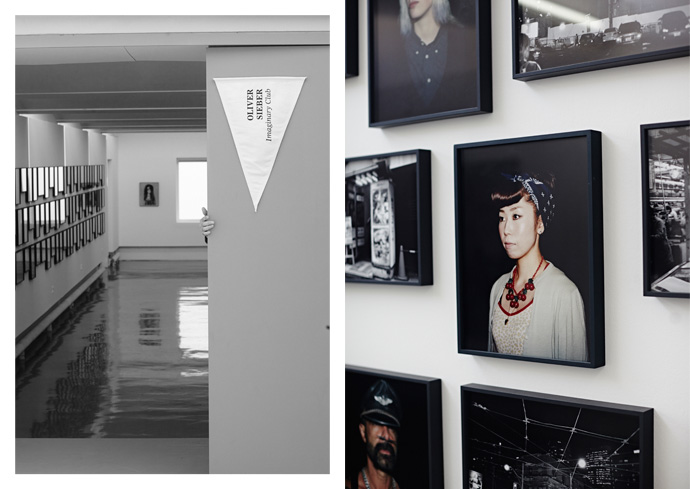
Oliver Sieber, "Imaginary Club": Exhibition at Villa Noailles, Hyeres
THE IMAGINARY CLUB
The Stimuleye: Who are these people in your “Imaginary Club”?
Oliver: What really interests me is reaction and forms of counter culture.
After WWII, the teenagers in America and England started to discover new forms of music and fashion, new forms of liberation. Many people I met are still in this sort of idea. Punk is a very good example, because it did have real societal meaning.That is what is important to teenager culture: upheaval, the struggle to identification, to root themselves. To not only take position against the elder generation, but in general. And that has often to do with music. I am interested in music, and communication of style codes.
The people in my “Imaginary Club” are not always part of a subculture in the classic sense. I have also portrayed artist friends, that, similar to teenagers, are forced to redefine themselves again and again. Here for example is a photo of Rebecca. From a wealthy family, she received always best grades, suddenly something switched in her head. Rebelling against her intellectual parents, she was climbing down the eaves gutters and was not to tame anymore.
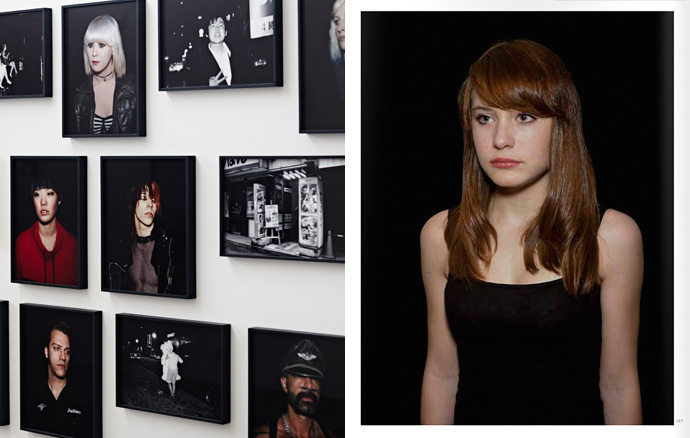
Oliver Sieber, "Imaginary Club": Exhibition at Villa Noailles, Hyeres. Right Side: Rebecca
When I look at my work, I understand it as an entry for the viewer, or a window upon which I reflect myself. Often it is not really about what is on the wall or who is depicted, but about the dialogue between the image and the onlooker. That changes from person to person.
The Stimuleye: Looking at the Portraits there are many Punks, Skinheads, Rockabillies.- is there also something a bit like nostalgia?
Oliver: We have a very globalized music culture today. Subcultures developing real novelties is something rather sparse and rare. Are there really subcultures that result from youth movements? I think it is not like that anymore. It’s more that youngsters try to identify with their role models of choice.
A good example is David Bowie that in the 70’s offered an image of “multi sexual liberation” for many people, also in combination with music and the song texts that bore a poetry and language that people picked up on. Just because we have 2014 now, his music did not disappear. You can still buy the records and the language still speaks to people who want to identify with it. And as fans do, they associate themselves with this. I think people living this don’t reflect on what they do, as we look at it. They just do it.
Katja:
There are always new aspects adding up and things get mixed up. So you have a development that can’t be called the “nostalgic”. It may be rooted in a source, and like in this case ideally there is a progression where new aspects ad up.Oliver Sieber, excepts from the book "Imaginary Club"
FASHION CODES AND THE INTERNET : THE NEW “FUCK YOU”
Katja:
Today you often cannot rely on the looks giving an indication on who people are: In Germany you find nazis that look like left anarchist “Antifa” fighters.
That possibly has to do with the internet, where you can communicate your stance or orientation in different ways then through fashion and dress codes.
You also have to react on other people adapting what you personally take serious as a subculture, how they mix your codes, abuse or pervert them.This makes it sometimes also difficult to determine whom are you following in a protest, where codes are so mixed up, that no one is able to keep up track.
For example in Ukraine its absolutely ambiguous who is protesting with whom recently. Unlike in the past, today it’s hard to determine who is on which side, from demonstrator to counter protester. Now you have young Nazi Hipsters in all black with tight jeans shouldering a jute bag, which really requires more than a second look to recognize what is going on.In this position you’re forced to find other forms to show your conviction that are different and function without the need of fashion as we had it in the past.
I am sure there are subcultures, but they function really differently, without the involvement of fashion, as the channels are much more multi layered. It’s not about provoking through your look anymore, because nowadays people are not easy to shock. So you have to find other ways and places to put your orientation forwards.Oliver Sieber, excepts from the book "Imaginary Club"
Oliver: In Japan a lot of messages get transported through flyers and stickers. This was similar in Los Angeles up until recently, but it changed and is now functioning mainly through hotmail panels. Everyone has a smartphone, no matter to which group you belong. The Cosplay culture for example functions only through the forums in the web. That’s all chat, appointments for conventions and Skype.
Katja:
But the internet is not at all as public as you may expect.
Often it’s very difficult to access a certain online group or forums. There are strict admins that want to know who you are and what you do, and remind you that with access you commit to a regular contribution etc- so you can’t just get in and check out. It’s much easier to go into a bar or a club, even if you have to pass and convince the bouncer.Oliver:
For example I photographed a young punk who realized how his style had been adapted and declared a trend. He totally changed his appearance to not be associated with this widely publicized new trend. That doesn’t mean though that his anti-ascist conviction or adoration for punk changed at all.As label and the designers pick up on elements of subculture their message is watered down extremely fast, so you have to have to change your codes again. As Jason (Evans) recently said at the Tate: “The new normal is the new ‘Fuck You,'”, because you can’t be categorized like this anymore.
Oliver Sieber, "Imaginary Club": Exhibition at Villa Noailles, Hyeres
PROTEST
Oliver:
That there is a new protest culture again is really great. These positions are getting from the internet to the street again, where you suddenly have to make an effort, as the codes we’re used to don’t work anymore when you can’t diversify between “good” and “evil”, nor recognize “your” or “my” people.Katja:
At the same time there is also these movements of parallel culture to create an existence and surrounding of some sorts of withdraw, even resigning.
This may be an approach resulting from being overwhelmed by societal developments. Specially in Japan we’ve met people that engage in small initiatives, artistic ones or others that take care of the homeless. There is this movement of “do it yourself” culture where people search for new forms of living for themselves apart from mainstream, norms and social graces, which are less visible.Oliver:
When visiting Osaka soon for another exhibit, we plan to investigate deeper into this, meet with these “alternative” people that found a totally different life and structure within of Japanese society.
What I found puzzling was that we met many homeless who spoke great English or Spanish, and had lived and worked abroad, but this had lead that they were not fully integrable any more into society, because the’ve been abroad too long and back in Japan landed on the street.Katja:
I think that also has to do that people with knowledge of languages have access to much more information over the internet for example, and thus are more open to ideas to try a different draft for their life than their parents, because that didn’t work that well either.
Specially as you can’t rely on social securities anymore- it’s not like our parent generation that studied, took a job and continued with a great retirement plan.Oliver Sieber, excepts from the book "Imaginary Club"
The Stimuleye: How do you work together?
Katja:
There are varying methods, but at times there are actual connections or a common greater theme and possibilities to juxtapose our work in an exhibition or we publish a book together for example at BöhmKobayashi.The City of Duesseldorf has provided us with a space we curated for three years where we developed “ANT!FOTO” which was to show exhibitions on positions of photography we feel were missing. As a result we also started a publication the “ANT!FOTO Manifest” which was a common project of us.
Oliver:
The “ANT!FOTO Manifest” was a project where we asked 70 photographer and curators to word their statement after a 10 point thesis we created. Initially this was planned only as a magazine, but finally will be shown in the Museum Folkwang as well as going to the
Fotomuseum Winterthur .The Stimuleye: What is the last thing that stimulated you?
Oliver:
After we talked so much on imagery, I would like to mention something that stimulated me:
when we talked to Frenkie (Bosnian Rapper) while visiting him in Tuzla, i asked him what is “heimat” (homeland) to him.
He said after being a refugee returning from Nuernberg to Tuzla, he realized what he missed: it was the scent of the firing wood that you can smell everywhere in the city. For my senses, apart from sound or music, the smell is very important.Oliver Sieber, excepts from the book "Imaginary Club"
Imaginary Club 2005-2012 432 pages, Offset-Print, a BöhmKobayashi/GwinZegal Joint
Imaginary Club is running at the Villa Noailles in Hyeres until may 25, 2014 and after that at the Galerie Stieglitz 19 in Antwerpen. Opening May 25, 2014, further dates are at PhotoBookMuseum from August 19, 2014 and after that the Exhibition will be travelling
-

#wrap-up #awards #alleyesonhyeres #2014
-#alleyesonhyeres indeed.
For its 29th edition, the fashion and photography festival reached new heights. More sunshine, more stars, more exhibitions, more public, more.
Here’s a wrap up of everything The Stimuleye covered in Hyères for those who missed it.
PHOTOGRAPHY
LORENZO VITTURI, GRAND JURY PRIZE
Italian photographer living in London Lorenzo Vitturi is the first to win 15 000 euros donated by Chanel, for his series “Dalston Anatomy.”
ORIANNE LOPES, SCHOOL OF VISUAL ARTS FUND
Orianne wins a scholarship to attend the School of Visual Arts’ “Photo Global” program in NYC.
VIRGINIE REBETEZ, SPECIAL MENTION OF THE JURY
Virginie wins a Leica S2 camera.
MARIE RIME, CITY OF HYERES AWARD
Awarded by the votes of the public of Hyères.
All the photographers in competition:
FASHION
CORALIE MARABELLE, CITY OF HYERES AWARD
Awarded by the votes of the public of Hyères.YULIA YEFIMTCHUK, SPECIAL MENTION OF THE JURY
Yulia’s collection will be carried by Opening Ceremony for the next 2 seasons.
CHLOE PRIZES
This year 2 Chloe prizes were awarded, each with a 15 000 euros fund:
ROSHI PORKAR
LISALORE FROWIJN
KENTA MATSHUSHIGE, GRAND PRIX DU JURY PREMIERE VISION
Kenta, who is from Japan but living and working in Paris, wins 15 000 euros given by Première Vision,
as well as a collaboration with Chanel Metiers d’Arts worth up to 15 000 euros, and a collaboration with Petit Bateau.ALL DESIGNERS IN COMPETITION + BONUS
THE FASHION SHOW
EXHIBITIONS – UNTIL MAY 25th
More info:
Villa Noailles, HyèresBONUS
The film directed by Antoine Asseraf & Julien Pujol about 2013 winner Satu Maaranen’s collaboration with Petit Bateau.
-

#AllEyesOnHyeres2014: Meet the 10 Competing Designers
-In preparation for their meeting with the Design Jury, the 10 Competing Designers hurried around making last-minute adjustments and consulting with stylists, while The Stimuleye spent some time getting to know each candidate.
Herewith, a selection of video, photography, and text that offer brief introductions to each of these talented young designers.
All Photos by Filep Motwary
Marit Ilison
Who are you? Your age, your origin, your background, type of collection?
My name is Marit Ilison, I’m 29 years old and live and work in Tallinn, Estonia. I have a diploma in pattern making and I studied one year as an exchange student at Danish Design School before receiving my MA degree in Fashion Design from the Estonian Academy of Arts in 2008. Since then I have been working as a freelance artist and designer, creating in the fields of conceptual art, fashion, costume design, site-specific installations, perceptional experiences and exhibition design. I also teach and play drums in a psychedelic band.How would you describe Hyères in three words?
Palms, unreal, friendly.What has been your favorite part of the process so far?
Meeting like-minded people and collaborating with small local artisans in Tallinn. It is so wonderful how so many people have believed in my work and helped me to execute it.What is your collection about? Please explain your inspiration and starting point, and how it has evolved in the process.
Regardless of the discipline, my main goal is always to create memorable experiences and I always start from a feeling I want to create or an idea I want to express. Longing for Sleep is inspired by my haunting wish to sleep during the dark wintery time called kaamos. Kaamos is a word only know in Estonian and Finnish and it’s referring to the time from November to January when the days are very short and it barely gets light. On one side I would only like to stay in bed and daydream at that time, but on the other side I feel conscience pricking me, which reminds that I should actually be working instead of sleeping. To materialize the feeling I’ve created a collection using original vintage Soviet woolen blankets.In what ways you think participating in a Festival like Hyeres will help you in the future?
It is a truly unique chance to present my work to wider audience and get the spotlight on it. I am looking forward to meet like-minded people and find exciting future collaborations in fashion design, site-specific installations and experiences.Louis Gabriel Nouchi
Who are you? Your age, your origin, your background, type of collection?
My name is Louis Gabriel Nouchi. Im french, I’m 26 years old. I live in Brussels. I’m studying at La Cambre.How would you describe Hyères in three words?
Intense, exciting, sunny.What has been your favorite part of the process so far?
To see my clothes worn by a real model.What is your collection about? Please explain your inspiration and starting point, and how it has evolved in the process.
I’ve made a collection about the movie Princess Mononoke from Hayao Miyasaki and the notion of balance between opposite forces that have to live together in harmony.In what ways you think participating in a Festival like Hyeres will help you in the future?
I hope it will help me to meet professionals and create contacts for whatever is going to happen after school.Liselore Frowjin
Who are you? Your age, your origin, your background, type of collection?
My name is Liselore Frowijn, I am 22 years old and I come from the Netherlands. I graduated Cum Laude less then a year ago at ArtEZ Institute of the Arts in Arnhem, the Netherlands, on my bachelor fashion design. I designed a collection womenswear which is about the contrast between sportswear and luxury with the use of self designed fabrics.How would you describe Hyeres in three words?
I would describe Hyères as exciting, energetic, and a creative meltingpot.What has been your favorite part of the process so far?
Regarding to the festival I think my favorite part of the process so far is to meet all the other designers and creatives, being together in the villa and working hard to create a beautiful festival.What is your collection about? Your inspiration and starting point and how it has evolved in the process.
My collection ‘’Afternoon Of A Replicant’’ is about the clash between sportswear and luxury, which is based on the cut-outs of Matisse. By cutting and pasting with paper, I created cut out-suits for women of my time. Above these suits are pieces of artisanal fabrics with self-designed prints, hand-painted or embroidered. The silhouettes are voluminous and layered. The transparency of fabrics causes an eclectic play-a-long between background and foreground: a fresh kind of luxury is the result.In what ways you think participating in a Festival like Hyeres will help you in the future?
I hope that Hyeres will bring me the right connections to help my career a level up in the fashion industry. I would like to work as a fashion designer womenswear in a house in for example Milan or Paris to gain more experience. Later on, I would like to have my own brand. By being part of this Festival all ten finalist are really put on the radar, a lot of people will notify our work, which can be very helpful.Agnese Narnicka
Who are you? Your age, your origin, your background, type of collection?
My name is Agnese Narnicka, I am from Latvia, Riga city. I received an M.A. from the Art Academy of Latvia in 2009. I have enriched my knowledge and experience in Accademia di Belle Arti di Brera, Italy, Milano. After graduating I started to work on my own label One Wolf. I will present menswear collection “Repair man.” Collection has urban shapes and multi layered look.How would you describe Hyeres in three words?
Bloom, Team, FutureWhat has been your favorite part of the process so far?
My speech rehearsal :}What is your collection about? Your inspiration and starting point and how it has evolved in the procedure.
The Inspiration for collection “Repair man” comes from my personal experience in 2012 when I was doing repair-works in my apartment. During this period I met several craftsmen whose personalities influenced the making of collection and are reflected in its characters. By taking off the old paint, by coating walls, painting, grinding and applying tiles I discovered many textures, colours and combinations of different materials.In what ways you think participating in a Festival like Hyeres will help you in the future?
The Hyères festival provides an opportunity to show my creations to a wider audience and to get new contacts. I really appreciate this opportunity!Coralie Marabelle
Who are you? Your age, your origin, your background, type of collection?
My name is Coralie Marabelle, I am French and I am from Paris. I am presenting a womenswear collection for the Hyères Festival.How would you describe Hyeres in three words?
Exciting, surprising, promising.What has been your favorite part of the process so far?
So far i have really enjoy discovering the Villa Noailles. It’s an amazing place full of history. I feel super excited to work in this place where so many amazing artists have come before.What is your collection about? Your inspiration and starting point and how it has evolved in the process.
My collection is inspired from a picture of persian sheep shearers in 1952. Inspired by a very masculine outfit, I dreamt of a very feminine woman.In what ways you think participating in a Festival like Hyères will help you in the future?
I think the Hyères festival gives us a lot of visibility which is amazing. It also give us the opportunity to meet a lot of people from the fashion industry.Anne Kluytenaar
Who are you? Your age, your origin, your background, type of collection?
My name is Anne Kluytenaar, I am 27 years old and I am from the Netherlands. My collection is menswear.How would you describe Hyères in three words?
Inspiring, exceptional, fun!What has been your favorite part of the process so far?
My favourite part so far was making the fabrics and creating embroidery.What is your collection about? Please explain your inspiration and starting point, and how it has evolved in the process.
I was inspired for my concept when my father told me one evening that he would continue to live life as a woman. She was not aware of the physical difference between women and men and would wear all the volume on the shoulders and wear a slim pencil skirt with it which augmented her masculine shape. To me the house of Chanel is a perfect example of luxurious elegance with a clear silhouette. Also their rich fabric and details were very inspiring.In what ways you think participating in a Festival like Hyeres will help you in the future?
It has opened me up to broader possibilities in the international fashion scene, allowing me to showcase my work to a wide audience and connect with industry professionals as well as like minded designers.Roshi Porkar
Who are you? Your age, your origin, your background, type of collection?
Roshi Porkar, 25, Vienna, women’s wear.What is your collection about? Please explain your inspiration and starting point, and how it has evolved in the process.
Feminine, fancy. fancy. The theme of the collection is based on a series of little statutes of stone, known as the Bactrian Princesses. I worked around the woman’s body, exaggerating the conventionally desired form for a woman’s body.
How would you describe Hyères in three words?
Exciting, emotional, exhausting.What has been your favorite part of the process so far?
Getting to know all the talented contestants and the jury members.In what ways you think participating in a Festival like Hyeres will help you in the future?
I just hope to be busy for the next few years.Pablo Henrard
Who are you? Your age, your origin, your background, type of collection?
My name is Pablo Henrad, I’m belgian and I just finished studying at La Cambre. I am presenting a menswear collection called Maelstrom.How would you describe Hyeres in three words?
Exciting, exhausting, and crazy.What has been your favorite part of the process so far?
To meet and to get to know all the contestants.What is your collection about? Your inspiration and starting point and how it has evolved in the process.
I worked on the darkness and the mystery of the untouched oceanic abyss. I questioned the notion of elegance, sensuality and sophistication in the masculine wardrobe.In what ways you think participating in a Festival like Hyères will help you in the future?
It surely helps because of all the interesting people we met here, the new connections and all the professionals.Kenta Matsushige
Who are you? Your age, your origin, your background, type of collection?
My name is Kenta Matsushige, I’m 25 years old, I’m from Yamaguchi in Japan. I studied fashion 2 years in Osaka and 2 years in Paris. Now I working as a freelance designer and modelist (pattern maker) in Paris. My collection is a womenswear collection.How would you describe Hyères in three words?
Nature, meeting people, collaborations.What has been your favorite part of the process so far?
All the process is really important for me, to create my own universe and work on volumes, fabrics, and find technical details or construction.What is your collection about? Your inspiration and starting point and how it has evolved in the process?
My collection was inspired by minimal structure, nature serenity, and traditional elements. I tried to find a balance between their confrontations.In what ways you think participating in a Festival like Hyères will help you in the future?
Hyeres gives me opportunities to collaborate with professionals and meet people who understand me and help me to create my universe. It will help me to create my own brand in the future.
Yulia Yefimtchuk
-

rocky
-The Stimuleye presents Chase The Cool, the first music video from the first of EP of Rocky.
CHASE THE COOL, written & directed by Antoine Asseraf & Rene Habermacher.
Your EP is very diverse sonically – is it because you’re still experimenting, or because you refuse to choose one style ?
Let’s say you can find in Rocky the influences we wanted to play with: House, Pop, R&B. All these musics are not so different, they all have their roots in African American music.Lille, Paris,… is it important where you’re from?
No. Today you can make the same music whether you’re from Lille, Paris or Madrid. Even though it’s true there isn’t the same energy in a big city like New York as in… Paris.Singing in French…is it taboo for you ?
Not at all. We’re thinking about it for the next EP.What’s it like playing the Olympia concert hall Jouer à l’Olympia? Inès, you mentionned you had already sung there before the Inrocks Festival…
You can say what you want, the Olympia isn’t a venue like any other. We were lucky enough to play it twice (the first time opening for The Shoes) and it was a great experience each time. The mood is peculiar, and you always get a reaction when you tell your family you’ll play there.What’s your process, from writing to production ?
There are no rules. But generally we start from a base by one of us, we push the production further and Inès tries to lay down some vocals. We go back and forth like this a few times, until we like it enough to play it to Pierre Le Ny, the Art Director of the label, who’ll put it in the trash.Sometimes, when he thinks the track is cool, he’ll send it Guillaume Brière (half of the The Shoes), who finalizes it and puts it on a record.
At least that’s how we do it now. It’s simple to tell, but in fact each step comes with its share of tears and despair.Where did the name Rocky come from?
We wanted a name that was cool, easy to remember, that would work in any language. This one was already part of the collective imagination, so the work was already done, which made it easy. We also liked the idea of highjacking an already ultra famous name from its origins. It never fails to trigger people to ask us about the name.What is the last thing which stimulated you ?
TRUE DETECTIVE !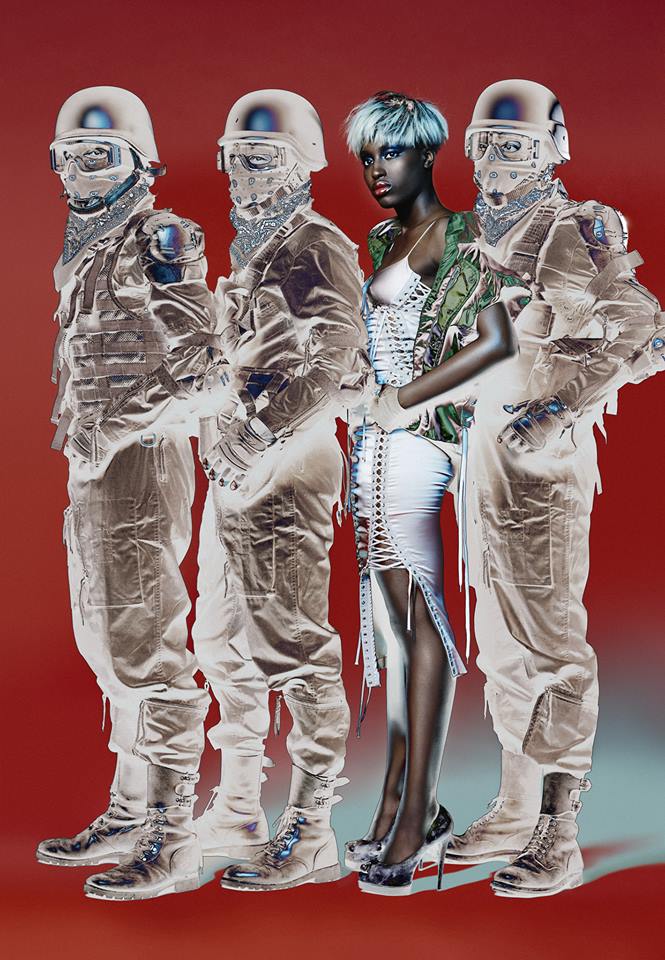 Rocky, by The Stimuleye.
Rocky, by The Stimuleye. -

#AllEyesOnHyeres: Humberto Leon and Carol Lim of KENZO, presidents of the fashion jury
-American designers Humberto Leon and Carol Lim surged into the global spotlight in 2002, as the co-founders of New York City’s preeminent boutique, Opening Ceremony. With its keenly curated selection of luxury brands, the shop quickly attracted the attention of the fashion world at large, and in July 2011, Leon and Lim were appointed as the creative directors of Parisian label KENZO.
Humberto Leon and Carol Lim, by Filep Motwary.
The strong friendship shared by this creative duo dates back to their years at UC Berkeley in California, where they met as students in early 2000. After a decade of successful project launches and hotly anticipated collaborations with other labels and designers, they continue to challenge fashion habits and to conceive new methods of design.
Today, both are enthralled by the KENZO spirit, which they perceive as a lifestyle all its own, and the label is shaped by the singular creativity born of their partnership. The originality and diversity of patterns and prints, the bright colours, music and rhythms of disparate cultures from around the world are all inspirations behind KENZO’s revival: under the guidance of Leon and Lim, it strives to achieve a universality which will seduce men and women of all ages.
Fashion has been a catalyst and playground for socio-cultural movements. Today’s trends are tracked from street to runway and back again at such speed that subcultures can barely exist beyond the brands. In what way do you feel today’s fashion is relevant?
Fashion has and always will be one of the easiest ways people can express themselves. We love drawing inspiration from everything around us: culture, art, music, food, travel, and from seeing what people are wearing on the streets. Today’s fashion, the product of a more connected world, is extremely relevant for what KENZO stands for today. That connectivity is what brings people together: streetwear melding with tailoring, night and day, comfort and style. All of these elements and more make fashion right now an extremely exciting place to be.
Do you think that something originally pegged as a luxury fashion brand could evolve into something that ends up being a mainstream feature? Is it a good thing being mainstream or not?
What some people seem to forget is that KENZO as a brand was never intended to be “luxury.” Kenzo Takada, when he founded the brand, dreamt of creating collections accessible to the street. We feel that mainstream isn’t a negative word and that mainstream fashion can still be heavily design oriented. KENZO has always been democratic, and since joining the company in 2011, we wanted people to remember this. Mainstream usually means something collectively appreciated and that is something we like to celebrate. We would love for KENZO to be a household name around the world.
Carol Lim, by The Stimuleye.
Do you think it’s always advisable for designers to be very visible, seemingly available to and engaged with their audience? Should relatability, especially in this age of social media and hyper connectivity, always be a goal? How should a designer understand himself or herself in relation to the consumer?
It really depends on the brand. For us at KENZO we love engaging with the customer because that is where you see if your collections are something people will want to buy and wear. We want people to understand who we are as a company, and in order to do that, we have to understand who they are as clients. Social media gives us a direct link to our customers and we love being able to have a dialogue with them. They can ask questions, discover more about our world and become a part of the KENZO community.
Humberto Leon, by The Stimuleye.
You’re surrounded by collaborators coming from very different directions. For KENZO, how important is the idea of “family,” and the creative exchange with its members?
It’s super important for us. Both at KENZO and Opening Ceremony we work with our friends. It creates an open dialogue and brings out the best ideas. Working with collaborators such as Spike Jonze or Chloe Sevigny, people we have known for such a long time, is a joy. It’s important to love what you do, and what could be better than brainstorming or working on projects with people you admire and respect on both a personal and professional level?
Talent is an obvious thing to look for in a contestant, but what other qualities do you think will be important to look for in a designer, right now, in 2014?
We will look for a strong point of view as well as for someone who understands the importance of the whole process of design. It is important to be able to understand the business aspects as well as all the creative ones. Also, we will look for someone who has both drive and a sense of humility.
What is the last thing you saw, read, heard or felt that stimulated you?
Carol: Nausicaa and the Valley of the Wind, an animated film by Miyazaki.
Humberto: Seeing The XX perform an 40 person intimate show in New York.
NOTE: Interview questions were put together by this year’s Hyères Festival Blog Partners:
Malibongwe Tyilo, Filep Motwary, Branko Popovic, The Stimuleye, Sean Santiago, The Kinsky. -

#AllEyesOnHyeres: Steve Hiett, president of the photo jury
-Steve Hiett pursued a Masters Degree from the Royal College of Art Graphic Design before his Swinging London years, which saw him travelling the world as the lead guitarist of Britain’s psych/pop group The Pyramid.
But it was not until an unfortunate accident on stage deprived him temporarily of his Fender—namely, electrocution from an ungrounded microphone—that he turned back toward his roots in the visual arts, and picked up a camera. Initially documenting his own group while on tour, he was soon photographing the international rock scene at large.
Steve Hiett, by The Stimuleye.
Over the past four decades, Hiett has pioneered a signature style that has become instrumental to the global world of fashion photography. Favoringover-saturated images, off-centre framing, unconventional compositions, and dazzling flash work, his work has been featured regularly in renowned magazines worldwide—from Nova and Queen to British Vogue, Vogue Paris, Elle, and Marie Claire.
The Hyères festival 2014 will present the first major exhibition of Hiett’s oeuvre, emphasizing the unsung aspects of his images and re-establishing him as a figurehead in the history of contemporary photography.
Steve Hiett lives in Paris, where he continues to work as a photographer for renowned fashion publications (notably for Vogue Italy), as well as a musician, graphic designer, and art director.
What was the process behind selecting the images for your exhibition at Hyeres? What will the visitors see?
Steve Hiett: Raphaëlle Stopin came to my place and looked through everything I could find. She selected the images.
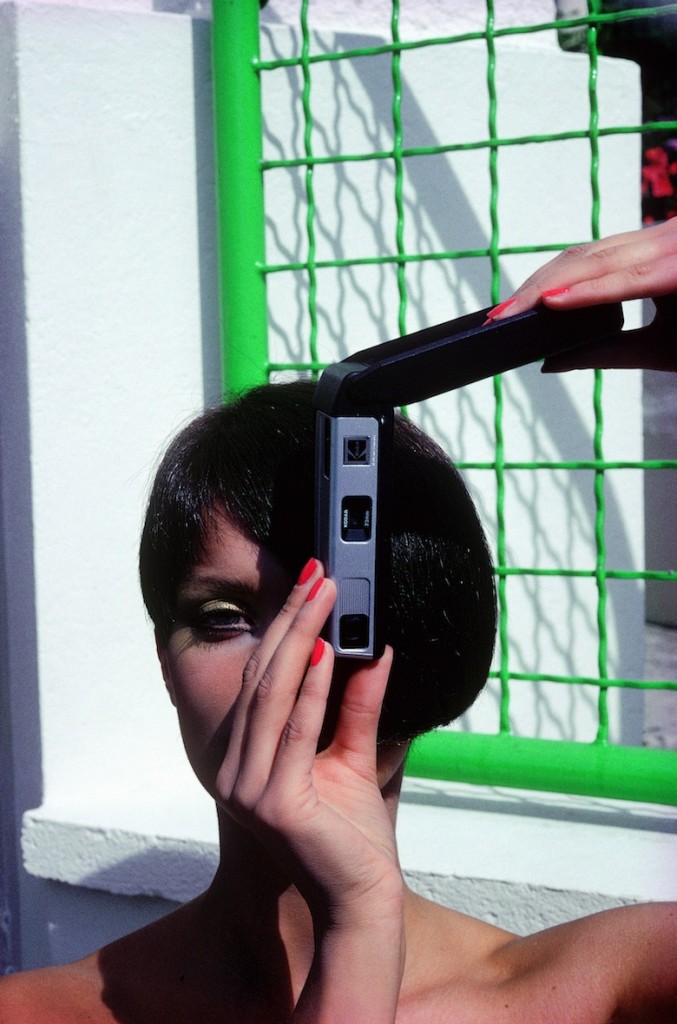
Steve Hiett, Vogue, 1979.
You didn’t plan to become a photographer, and it seems that your early photography was informed by your circumstances while you were on tour. Considering how digital and technological developments throughout media have changed the landscape of photography, what kind of career path do you think you would find yourself upon if you were only beginning your career in the present day? How would a young Steve Hiett go about his business in 2014?
SH: Starting today? I have no idea. Fashion photography is such a complex thing now; lots of politics and all the digital processes, which makes doing a photo so long and complicated. When I started, you just walked into a magazine and the art director would give you a job. I don’t think you can do that now. Also, to take a photo, you took a light reading, pressed the button and that was it; what you got back from the lab was it—end of story. Now you are dealing with all sorts of choices and the new world of retouching, which can go on for days. I worked for 30 years and never retouched anything. It never entered my head (or any other fashion photographer) as even a possibility.
Steve Hiett, 1979.
Looking back over your career as fashion photographer, is there a certain period in time that stands out for you in particular?
SH:Starting. I knew nothing, but it didn’t matter.
Having worked through the last few decades of fashion photography, what kinds of major aesthetic shifts have you noticed?
SH: Now the boss is the fashion editor. They decide who works and who doesn’t, but before it was the art director.
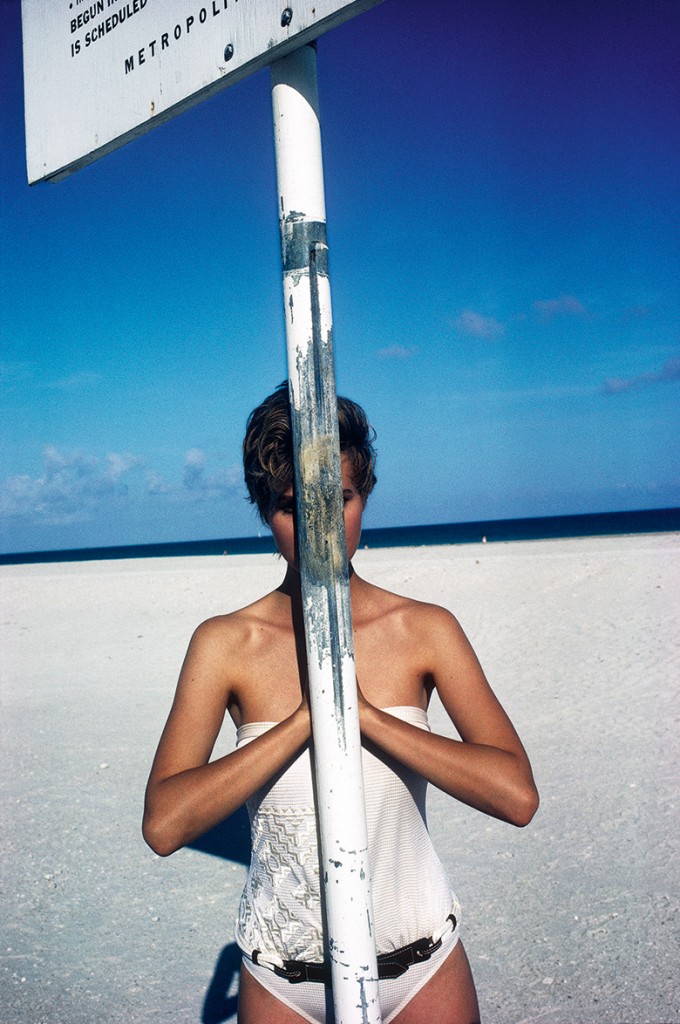
Steve Hiett, 1979.
There is always some sort of tension in your photography. How do you achieve it?
SH: Tension in my pictures? That must be subconscious: I never look for tension. I look for the right feeling.
What is the last thing that stimulated you?
SH:The last thing that stimulated me? Steve Cropper’s guitar solo on “Green Onions,” which I have listened to 1000 times. I listened to it again last night; still has that magic. OK, I know the notes he plays, but it goes way beyond that—it’s a magic thing.
NOTE: Interview questions were put together by this year’s Hyères Festival Blog Partners:
Malibongwe Tyilo, Filep Motwary, Branko Popovic, The Stimuleye, Sean Santiago, The Kinsky. -

#alleyesonhyeres
-Hyères Hyères, Hyères-Hyères Hyères Hyères !
(Translation: and now it’s time for our 2014 Hyères preview)
Starring jury members Carol Lim & Humberto Leon of KENZO, photographer Steve Hiett, Chloé Sevigny, Manish Arora, and many more…
Of course, we’ll be keeping you up to date with all the news from the festival in the weeks to come… #AllEyesOnHyères
Directed by Antoine Asseraf for The Stimuleye
Set by Mathilde Nivet -

rocky
- -

all eyes on hyères
-Last Hyères before it turns 30.
For its 29th edition, Villa Noailles director and Fashion + Photography founder Jean-Pierre Blanc invited the American duo of Humberto Leon and Carol Lim, Kenzo designers and Opening Ceremony founders, to preside the Fashion Jury.
Amidst hundred’s of applicants from 55 different countries, here are the 10 finalists they picked.
Official lookbook by The Stimuleye.
Hyères 2014 - ALL EYES ON HYERES - by The Stimuleye.
All 10 designers were selected on the basis of a dossier and a full outfit, first by art director Maida Gregory-Boina, Maria Luisa buyer Robin Schulié and The Stimuleye colleague Filep Motwary, then by the jury presidents and their guests: Jay Massacret (V Man), Eric Wilson (InStyle), Carol Song (Opening Ceremony) and actress Chloé Sevigny.
(more…) -

Merry Xmas, Mister Sakamoto.
-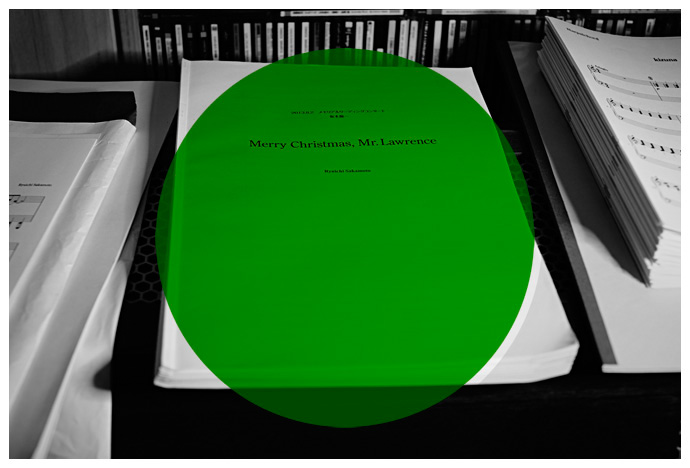 Manuscript to the score of "Furyo" by Ryuichi Sakamoto. Photography René Habermacher.
Manuscript to the score of "Furyo" by Ryuichi Sakamoto. Photography René Habermacher.It doesn’t quite add up.
There are the many facets of Ryuichi Sakamoto, but putting them together, you still wouldn’t get a sense of who the man is.
He is both an icon of Japan’s 1980’s Bubble Era, and the one who moved beyond Japan and away from the spotlight, a consistent experimentalist and accidental sex-symbol.
Founding member of the influential band Yellow Magic Orchestra, Japan’s answer to Kraftwerk.
Musical innovator for over 30 years, mixing synthpop, Okinawan traditions, sampling, bossa nova….
Screen-mate of David Bowie in the cult film “Merry Christmas, Mr. Lawrence” / “Furyo.”
Film composer for Almodovar, Oshima, Bertolucci, Oliver Stone and Brian de Palma.
Collaborating with David Byrne, Brian Wilson, Youssou N’Dour and the Dalai Lama.
Appearing in Madonna’s “Rain” music video.
Sampled by Afrika Bambaataa…and Mariah Carey.And last but not least, well before the Fukushima accident, a prominent activist in Japan’s anti-nuclear effort.
It doesn’t quite add up, and that’s really for the best, as we found out after spending an afternoon with him in New York City
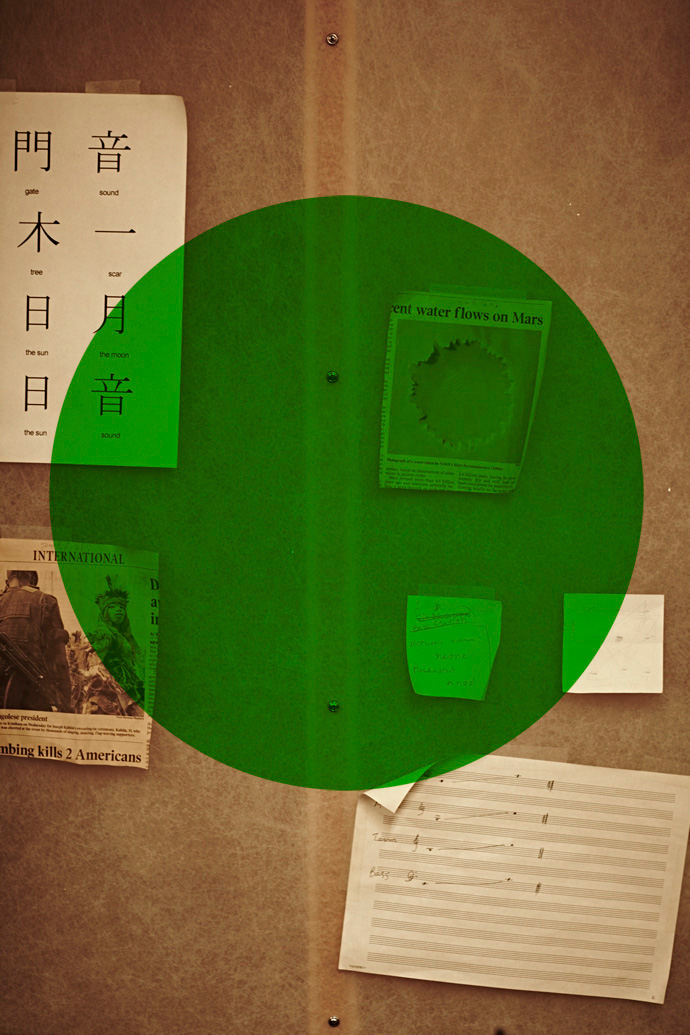
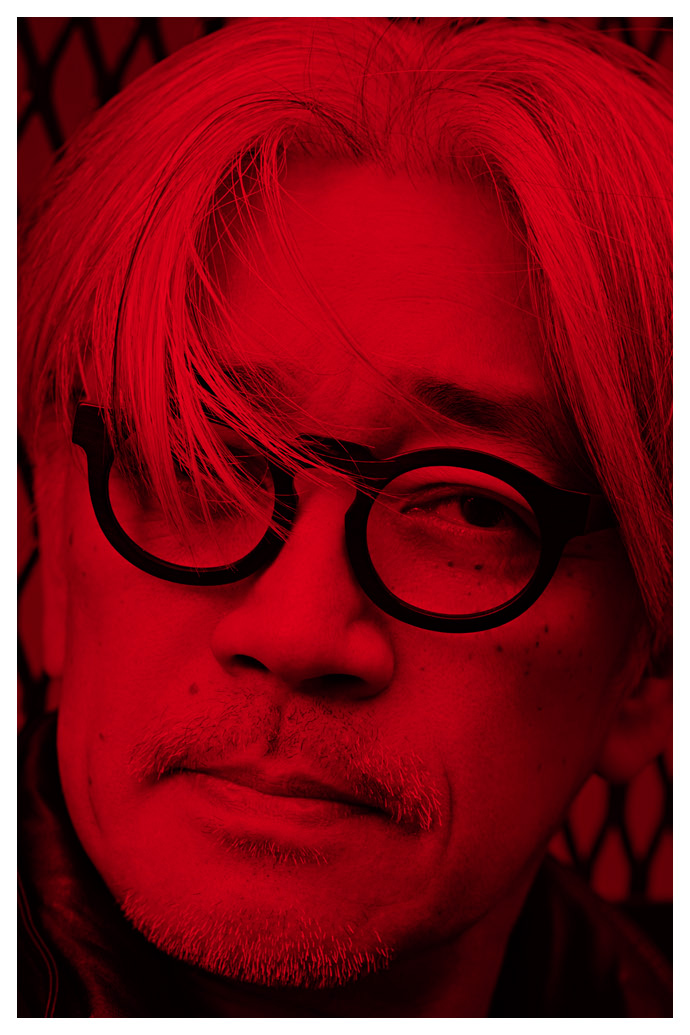 Left: inspiration board. Right: Ryuichi Sakamoto. Photography by René Habermacher.
Left: inspiration board. Right: Ryuichi Sakamoto. Photography by René Habermacher.The Stimuleye: When did you first feel personally concerned with the nuclear issue?
Ryuchi Sakamoto: Probably I started feeling anxious about it around the time of Chernobyl. Then I encountered the facts about the nuclear reprocessing plant in the northern part of Japan called Rokkasho. It was 7 years ago, pretty recent.
It’s not a usual nuclear plant, it’s to re-use, re-process used radioactive wastes. Through the processing, you emit hundreds of time more radioactive materials than the usual nuclear plant does. You get 365 nuclear plants in 1 village. Very dangerous.
So I started a web campaign, called Stop Rokkasho, I asked Kraftwerk to give us a sound logo, and they did actually ! The pretty famous graphic designer Jonathan Barnbrook had his assistant design the webpage, which was very neat.
As a web campaign it succeeded, my friends – photographers, musicians, stylists, creative people got to know about this plant. We decided to make a Stop Rokkasho tshirt, we asked more than 50 designers to make a tshirt. They needed phrases, so I gave them “No Nukes. More Trees.”
Everybody loved it, especially the second line.
It’s very easy to understand, and no one can resist.So, I decided to form a company called “More Trees”, it’s been 6 years, and we’ve been doing mainly conservation of Japanese forests. We have now 11 forests in Japan and 1 in Philippines.
(more…) -

what the FIAC ?!
-OK people, fashion time’s over. It’s Art time.
Appetite for contemporary art is always growing. The public, the collectors…everyone wants a piece of the cake.
So The Stimuleye is proud to present, for the second year in a row in association with SayWho, the official film of the 40th Paris Contemporary Art Fair a.k.a. FIAC 2013.
WhatTheFIAC, written & directed by Antoine Asseraf.
FIAC, Foire Internationale d'Art Contemporain, 2013 trailer, directed by Antoine Asseraf.
For its 40th edition, and in order to accommodate the ever-growing interest in the art scene, the FIAC is expanding and taking different forms throughout Paris.
Beyond the glass dome of the Grand Palais and the hundreds of galleries showing there, the FIAC is installing artwork accessible for free to the public in its “Hors-les-murs” (‘outside the walls’) program. Prestigious locations such as the Jardin des Tuileries, Place Vendôme, and Jardin des Plantes are joined this year by the brand new Berges de Seine left bank pedestrian embankments, running from Musée d’Orsay to Quai Branly.
YUM.
FIAC 2013. Photo by René Habermacher.
FIAC 2013
October 24-27
Grand Palais
& Hors-les-Murs: Petit Palais / Berges de Seine / Jardin des Tuileries / Auditorium du Louvre / Place Vendôme / Jardin des TuileriesWhatTheFIAC
produced by SayWho
creative direction The Stimuleye
directed by Antoine Asseraf
photography by René Habermacher
art direction by Mathilde Nivet
hands by Aurélie Nguyen
voice by Lynsey Peisinger -

fashion time – adolfo dominguez
-Last but not least for the fall, we had the chance to film model Andreea Diaconu alongside photographer Karim Sadli for Adolfo Dominguez…
Adolfo Dominguez FW 2013/14, film by Antoine Asseraf, in collaboration with Karim Sadli.
-

fashion time – elie saab magic moments
-For the this fall, we collaborated with Elie Saab to create cinematic “magic moments” around their fashion shows.
Cool but dramatic blue for ready to wear.
Royal but intense red for couture.ELIE SAAB FW 2013/14 Ready To Wear, "STRICTLY DECORATIVE".
ELIE SAAB FW 2013/14 Couture, "A Royal Affair".
Directed by Antoine Asseraf
Produced by Premices Films
Assisted by Julien Pujol -

fashion time – andam award 2013
-It’s that time of the year again – fashion week.
First up is the ANDAM award, one of the biggest and oldest fashion awards, which for it’s first edition had rewarded the work of a young man named Martin Margiela…
Now it’s 2013 and the ANDAM jury is supporting the accessible menswear of AMI (“friend”) aka Alexandre Mattiussi.
a PREMICES FILMS production
with THE STIMULEYEmore info,
ANDAM.fr
